

We are currently seeking two PhDs and one Postdoc (3 years each) in Marine Evolutionary Ecology, with a broad focus on ecological and oceanographic modelling, plus one PhD in marine sustainability.
26 May 2025
The application deadline is 15 June 2025. Master’s students are welcome to apply for the PhD positions, provided they complete their final master’s examination before 1 September 2025. Further details about these positions and how to apply can be found here: PhD Research Fellow – Two Positions in Marine Evolutionary Ecology
A postdoctoral position focused on bioacoustics analysis and modelling is also part of the DRIFT project. The primary responsibility of the postdoctoral research fellow will be to lead the analysis of field data and integrate it with ongoing modelling efforts in the project. In particular, the fellow will analyse a three-decade acoustic time series collected via an array of Acoustic Doppler Current Profiler moorings positioned around the Faroese shelf. Depending on the candidate’s disposition, skills, and interests, the position may evolve in one of two directions: (1) conducting a trait-based analysis of over 30 years of fisheries survey data from the Faroe Marine Research Institute to compare slope communities upstream and downstream of the shelf, or (2) contributing to the development of mechanistic simulation models for adaptive behaviour of predators and prey along shelf ecosystems.
The position offers opportunities to gain experience in project coordination and scientific leadership, including involvement in the planning of a research cruise and co-supervision of Master’s students.
The application deadline is 15 June 2025.PhD students may apply for the postdoctoral position if they defend their PhD thesis by 31 December 2025. More info here: Postdoctoral Research Fellow Position in Marine Evolutionary Ecology
Finally, there is a PhD position in marine sustainability in a joint project between the University of Bergen and the Institute of Marine Research, co-supervised by professor Katja Enberg. The aim of this project is to develop quantitative and qualitative parameters related to different sustainability dimensions that can supplement data on safe and healthy seafoods with indicators of sustainability relevance. Application deadline for this position is 9 June 2025. For details, see PhD Research Fellow in seafood and sustainability
This week, Anders F. Opdal’s popular science article on cod spawning behaviour made the front cover of the Norwegian journal Naturen. The article summarizes two recent scientific studies emphasising the role of individual plasticity in spawning behaviour for Atlantic cod.
24 March 2025
The popular science article by is based on two scientific articles from 2024, which where central milestones in the RCN project TerraCoast.
Together with colleagues from TEG, UiO, and IMR, Opdal analysed the variation in spawning time of Atlantic cod in Lofoten over the period 1877 to 2021 (Opdal et al. 2024 in Global Change Biology) and along the entire Norwegian coast between 1980 and 2019 (Opdal et al. 2024 in Ecology).
They found that increased vegetation on land, freshwater browning, and coastal water darkening during the 20th century has altered the timing of the spring phytoplankton bloom. However, they also discovered a remarkable and quite astonishing flexibility in the cod spawning behaviour, suggesting it can change spawning time in order to remain “in sync” with the bloom onset, both across time and space.
The
Olav Thon Foundation awarded its national teaching prize to professor Katja Enberg. The prize recognizes excellent teching within STEM (science, technology, engineering, and medicine).
7 March 2025
The committee writes:
Enberg’s teaching - and research - has sustainable food systems as a main focus, combining theoretical and empirical methods, scientific cruises, and fieldwork. Her teaching is built around student-active learning methods and she shares her experiences with others through lectures and articles about teaching.
Professor Monica Jordheim at the Department of Chemistry also received the prize this year. They will, together with seven other recipients, be awarded the prize at a ceremony in Oslo in May. For further information, see [in Norwegian]:
Marc Mangel just released his new book Fighting the virus: Disease modeling and cyber security. He shows that many of the concepts and methods used in biological modelling of infectious diseases help shed light on cyber security and computer viruses.
17 December 2024

Front cover of Marc Mangel’s new book.
Here is what some of the reviews say:
Some of the most groundbreaking scientific advancements occur when researchers take insights from one discipline and apply them to others. This book is a remarkable achievement, skillfully drawing parallels between biological and cyber systems in a way that enhances our understanding of both fields. Professor Tom Sherrat, Carleton University, Ottawa, Canada.
The book also reveals the inestimable value of thinking across disciplines. Mangel brings principles of disease ecology to the problems of cyber security, two areas of study that might seem, at first glance, to be unrelated. He shows how methods used in one area offer novel insights into the other. In an age of ever-increasing specialization in expertise, this book highlights the power of mathematics to unite disciplines and enable researchers with different backgrounds to find synergy in collaboration.Professor Joseph Travis, Florida State University, USA
TEG researcher Sergey Budaev has together with professor Ivar Rønnestad developed a web-based model for optimizing feeding strategies in salmon aquaculture.
10 December 2024
By including hormonal control and a detailed understanding of fish digestion combined with loads of data from aquaculture facilities, the model predicts digestion, growth, and appetite in the fish. The goal is that such information can improve fish welfare and reduce feed spill.
The project was financed by VIS innovation, the technology transfer office (TTO) of the University of Bergen and other institutions in our neighbourhood.
Read more at the VIS Innovation website [switch between Norwegian and English in top-right corner of web page].
Congratulations to Tom J. Langbehn on receiving the prestigious Starting Grant from the
Trond Mohn Research Foundation! The project,
Systematically rethinking advection and cross-ecosystem subsidies,
aims to uncover the mechanisms that determine when and where prey from the open ocean becomes accessible to predators.
9 December 2024

From the award ceremony 6 December 2024. From left: Vice-Rector for Innovation, Projects and Knowledge Clusters Gottfried Greve, Tom Langbehn, Leonardo Muniz Pichel from Department of Geoscience who also got a Starting Grant, Trond Mohn, and host Arne Møller. Photo: Sigrunn Eliassen.
The planned research seeks to map hotspots of efficient energy transfer throughout the North Atlantic, and predict how advected biomass influences production, life-history strategies, and species distributions in the receiving ecosystems.
See Tom Langbehn talk about his research here (Producer: Håvard Kroken Holme/UiB, Copyright: UiB):
Gabriella Ljungström was invited to hold a presentation about landings in pelagic fisheries for direct consumption versus fish meal and oil at Fiskebåt Sør’s annual meeting in Bergen.
4 December 2024
Gabriella presented results from an ongoing study on fuel use intensity (liters of fuel used per kilo of fish caught) of catches for food versus feed, showing that contrary to the general expectation and despite larger catches, fishing for meal and oil is not necessarily more fuel efficient. Hence, a lower fuel cost is not an incentive for fishing for meal and oil rather than direct consumption. From the perspecitve of food security, equity, and environmental impact, this can be good news as it is preferrable that pelagic fish are consumed directly.
See more on Fiskebåt’s web pages.
Jessica Tengvall defended her PhD-thesis on 25 October 2024. Her opponents were Eydna í Homrum from the Faroe Marine Institute and Raul Primicerio from the University of Tromsø.
31 October 2024

Opponents Eydna í Homrum and Raul Primicerio together with the freshly baked PhD Tengvall.
In her thesis, Jessica has worked with one of the most important, yet most difficult-to-estimate parameters in marine and fisheries ecology – natural mortality. Her work has spanned from spatial predator-prey interactions to the role of natural mortality for fisheries reference points and harvest control rules. She was supervised by Katja Enberg, Fabian Zimmermann from the Institute of Marine Research, David Miller from the International Council for the Exploration of the Seas, and Anders F. Opdal.
A PhD position funded by the
Department of Biological Sciences with workplace at
Institute of Marine Research
is now announced. The project is supervised by Amund Maage as main supervisor and Katja Enberg in TEG as cosupervisor. Deadline for application is 1 November 2024.
4 October 2024
This is how the call describes the project:
Over time, IMR has built up a large database (Seafood data) on the content of nutrients and contaminants in various seafood. The aim of this project is to develop quantitative and qualitative parameters related to different sustainability dimensions that can supplement data on safe and healthy food with indicators of relevance. The project is a pioneering project at IMR, where collaboration with various professional groups and research fields, both internally at IMR and UiB, but also in collaboration with others, is essential.
See JobbNorge for the full announcement:
https://www.jobbnorge.no/en/available-jobs/job/268761/phd-research-fellow-in-seafood-and-sustainability
Tom Langbehn gave the Early Career Keynote at the
2024 ICES Annual Science Conference
in Gateshead, UK, at the end of September. The title of his talk was The ecological mechanics of light and life in the open ocean. A recording has now been made available online by ICES.
3 October 2024
You can view the video at ICES’ YouTube channel or here:
It is wonderful to see how in the summary video made by the conference, several past and current TEG members are shown engaging in presentation and discussion: Jessica Tengvall, Johanna Aarseth, and Dorothy Dankel.
At the annual conference of the Society of Mathematical Biology, Marc Mangel joined a prestigeous group of distinguished scientists as he was awarded the honour of a Society of Mathematical Biology Fellow.
2 October 2024
As soon as their web pages have been updated, he will be listed here with all the previously awarded Fellows:
https://smb.org/Society-for-Mathematical-Biology-Fellows
As our four-year project on the fundamental role of mesopelagic fishes in the structure and change of Northeast Atlantic marine ecosystems comes to an end, and with Dag L. Aksnes retiring from his formal duties at the university, we found a perfect opportunity to host an international workshop on Light as a Driver in Marine Ecology.
23 September 2024

In addition to through-provoking presentations, there was lots of time set aside for discussions and questions. Here Stein Kaartvedt from University of Oslo is sharing his insights.
The workshop aimed to synthesize current understanding, celebrate Dag’s legacy, and most importantly, look forward by identifying emerging questions and common ground for future collaborations. We received an overwhelmingly positive response to our initial invitations.
The event brought together many old and new friends and a good mix across all career stages. Over 50 colleagues from 13 different institutes, including the British Antarctic Survey, Scripps Institution of Oceanography, Alfred Wegener Institute for Polar and Marine Research, AZTI, Scottish Association for Marine Science, and DTU Aqua, among others, joined us in Bergen 19-20 September. Participants from no less than 8 countries in Europe and overseas engaged in two stimulating days of discussions and presentations.

The workshop brought together over 50 colleagues from 13 different institutes and eight countries.
Henrik Høiberg Jessen defended his PhD thesis today, in insightful discussions with the opponents Anna Kuparinen (University of Jyväskylää, Finland) and Geir Ottersen (Insitute of Marine Research, Oslo).
8 February 2024

The opponents gave Henrik credit for a nice figure summarizing his model and research.
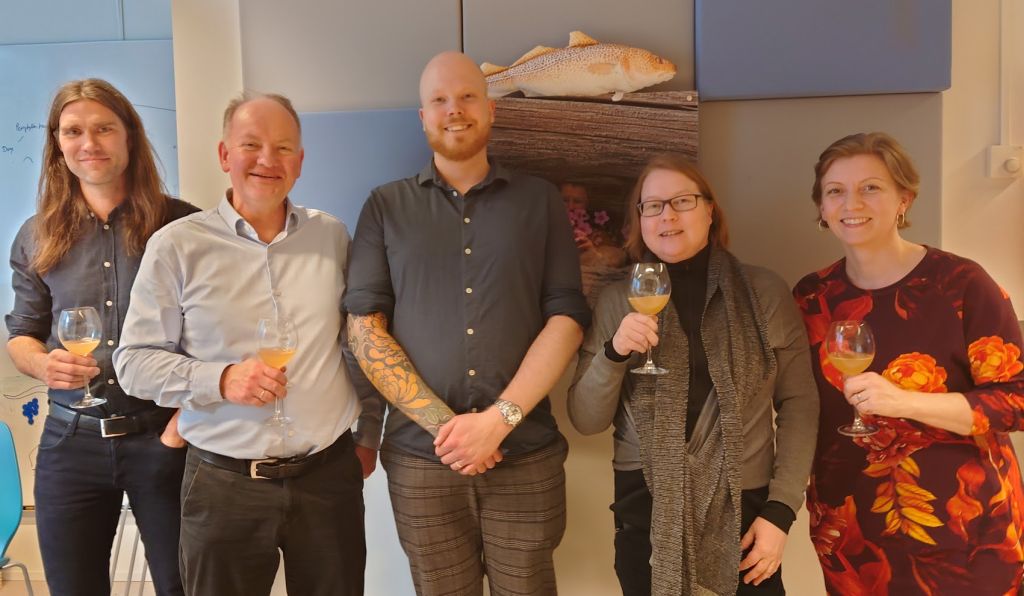
From left to right: supervisor Anders Opdal, opponent Geir Ottersen, Henrik himself, opponent Anna Kuparinen, and supervisor Katja Enberg.
In a study published today in Marine Policy, TEG researchers have unveiled striking evidence that management decisions such as spatial restrictions of fisheries can increase greenhouse gas emissions. The study, conducted by a team of scientists led by postdoctoral researcher Kim Scherrer sheds light on the unforeseen consequences of policy changes on fishing fleets and their carbon footprint.
5 February 2024
In the North Atlantic, international agreements often allow fleets to follow the fish across national borders. This allows fishers to catch the fish where it may be done in the most efficient way. But when the UK left the EU, also known as Brexit, Norway’s mackerel fishing fleet was suddenly excluded from fishing grounds in the UK. Using Brexit as a natural experiment, researchers used open fisheries data to unravel the consequences for the Norwegian mackerel fishery. The findings revealed an alarming shift in the fishery’s performance and carbon emissions due to the changes in targeting pattern.
As the Norwegian fleet was excluded from UK fishing grounds, the catch per fishing trip nearly halved, prompting a doubling in the number of trips per vessel. Consequently, the fuel used per kilo of mackerel more than doubled.
Because of this change, an extra 23 million liters of fuel were needed each year, costing about €18 million more. Also, this caused an extra 72 000 tonnes of CO2 to be released into the air annually. The changes thus undid about 15 years of progress in fuel efficiency in Norway’s pelagic fisheries.
“This small change in fisheries’ regulations unintentionally caused as much emissions as half a million within-EU return flights annually,” said Scherrer, emphasizing the necessity of considering emissions in fisheries management. “It is important that governments that have signed the Paris agreement avoid squandering emissions like this”.
The study underscores the crucial need for policymakers and managers to consider fuel efficiency trade-offs in marine spatial management, ensuring a balance between conservation efforts, other offshore industries and reduced carbon footprints.
The study has been picked up by several news outlets (in Norwegian):
Fiskeribladet: Studie: Brexit doblet karbonfotavtrykket til makrellflåten
Teknisk Ukeblad: UiB-studie: Brexit førte til at utslippene fra den norske makrellflaten doblet seg
View this press release on
UiB webpages or at
NTB.no.
At Runde Miljøsenter, around 50 participants gathered to attend this year’s Havforskarmøte (The annual meeting of The Norwegian Association for Ocean Researchers) November 20-22. The theme was Food from the ocean and attracted attendance from wide range of fields, including technicians, researchers, and students from universities and research institutes as well as invited entrepreneurs, owners, and employees of alternative marine food production systems, including zooplankton, kelp and tunicates.
13 December 2023
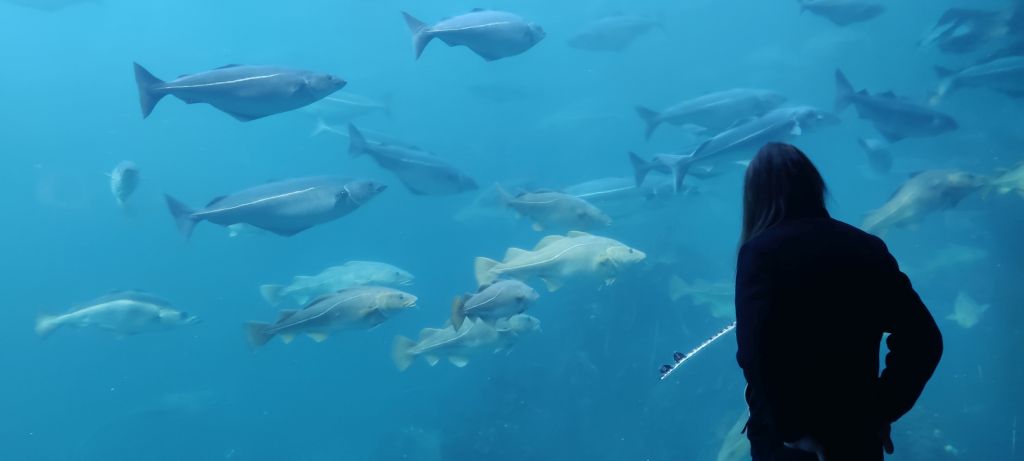
Fish and researcher trying to make sense of each other.
The Institute of Biological Sciences was well represented through the research groups Theoretical Ecology (TEG), Fjord and Coastal Ecology and Environmental Toxicology.
From TEG, Øyvind Fiksen, the chair of Norsk Havforskerforening, was leading the meeting, while Kim Scherrer opened the scientific program with a keynote on the concept of sustainable fisheries, and was later part of the panel debate on the same topic. Tom J. Langbehn presented an upcoming article on the effect of Brexit on the fuel consumption of the Norwegian pelagic fishing fleet - a joint effort from the Future fisheries project. Anders F. Opdal presented the effect of coastal water darkening on phytoplankton bloom and fish spawning time along the Norwegian coast - the latest results from the TerraCoast project.
From Fjord and Coastal Ecology, Prof. Anne Gro Vea Salvanes, postdoctor Natalya D. Gallo, PhD student Francesco Saltalamacchia, and master’s student Sigrid Kjelstad presented the latest findings from the RCN project HyponFjordFish regarding effects of hypoxic conditions on fjord ecology – with particular emphasis on the Masfjord.
Anders Goksøyr from Environmental toxicology had the honour of closing the meeting, presenting a newly started RCN research project on bioaccumulation of toxins in whales and polar bears.
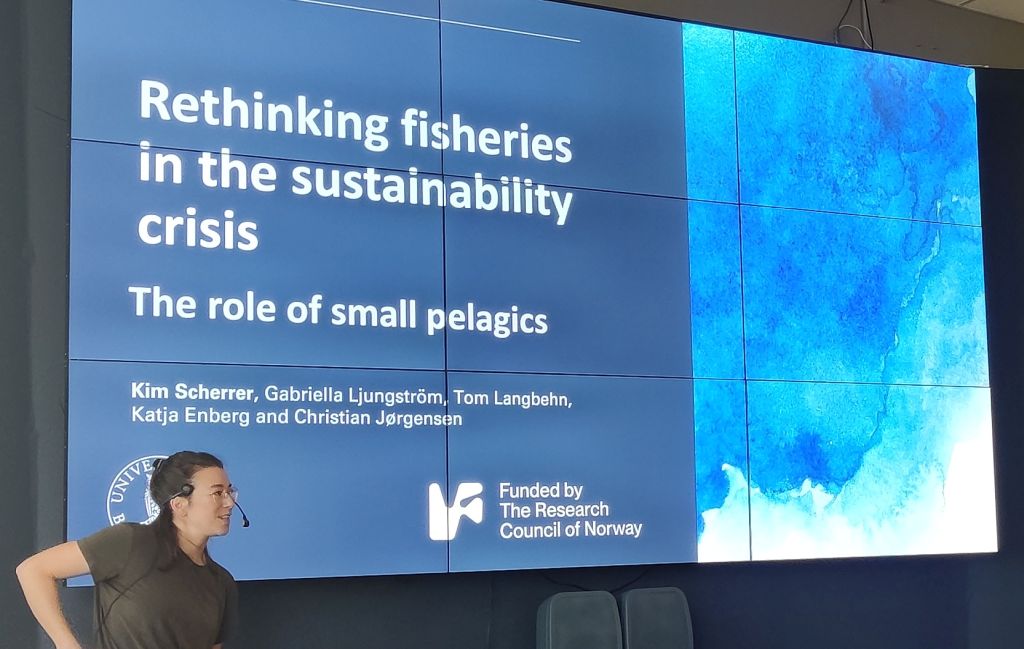
Kim is ready for action.
Agnieszka Rumińska on 9 October defended her PhD degree on extrapair mating in birds. She had used evolving individual-based simulations to study evolution of cooperation in neighbourhoods of breeding birds.The expected mechanism is that males with offspring in several nests are more likely to work for the good of the neighbourhood because that may enhance the fitness of all their offspring.
7 November 2023

Agnieszka presents her thesis research, with beautifully drawn illustrations.
With a newly developed individual-based simulation model, Agnieszka could address some of the open questions left unanswered by a 2014 paper. In her new model, extra-pair mating as a female strategy incentivizes males to share resources and behave more cooperatively. This happened despite abundant levels of noise, which so although involving interactions among many individuals, the selection for cooperative behaviours is not weak.

Opponents were Rose Thorogood from University of Helsinki, Finland, and Andy Higginson from The Univeristy of Exeter, UK.
Two of her chapters are already published:
Last week the
5th Symposium on the Effects of Climate Change on the World’s Ocean
was arranged in Bergen. The conference was attended by more than 700 participants from 71 countries in person and online. In parallel, the inaugural
OneOcean week
took place with a range of meetings, workshops, and activities - pioneering a sustainable use of the ocean.
26 April 2023
TEG was well-represented with many of us participating in either, or even both events.
Gabriella Ljungström, Tom J. Langbehn, and Øyvind Fiksen presented insights from mechanistic models on emerging Bergman patterns, photic barriers to species range shifts, and optimal spawning times in bluefin tuna in the session Beyond species on the move: emerging climate change impacts on the spatial dynamics of marine species, from detecting to forecasting and projecting. Anders F. Opdal presented a poster on trophic synchrony across space and time of Barents Sea cod during their spawning migration in the same session. One conclusion from all four presentations was that we need to look beyond temperature-driven physiology to understand animal distributions and phenology.
Henrik Høiberg Jessen presented a poster on the Evolution of Northeast Arctic cod in response to concurrent fisheries and climate stressors.

Top from left: Kim discussing Henrik’s poster, Gabriella and Øyvind presenting. Bottom from left: Anders with his poster and Kim presenting at the ECCWO5 conference, and Øyvind discussing during OneOcean Week.
Kim Scherrer, Katja Enberg, Øyvind Fiksen, and Dag L. Aksnes were heavily involved in both events, participating in panel debates, giving public outreach talks, and discussing the sustainable use of the oceans with industry partners and investors. The common theme in their contributions was the question: How can fisheries contribute more to a sustainable future? Kim Scherrer also presented recent work showing that carbon emissions from Norwegian fisheries have increased immensely because Brexit affected access of the Norwegian fleet to fishing grounds in British waters.
On the social side, it was great to catch up with Sara Hornborg (RISE Research Institutes of Sweden) and Elena Oja (University of Vigo, Spain), two of our international partners in the Future Fisheries project.
Tom received an award for an outstanding oral presentation, congratulations!
In Bergens Tidende today, Dag L. Aksnes criticizes the authorities for forgetting Norway’s impressive seafood industry in its strategy for food security in times of crisis. Scaling up Norway’s meat industry to prepare for crisis is not sustainable, eating the seafood already produced is smarter and greener, accordign to Aksnes. If anything, meat production should be scaled down to free farmland for grain, vegetables, and fruit where possible.
25 April 2023
His opinion piece can be read here:
https://www.bt.no/btmeninger/debatt/i/RGlRVx/at-vi-spiser-mindre-kjoett-truer-ikke-norsk-matberedskap
or
downloaded.
In a newly published paper in Limnology and Oceanography Letters, Anders F. Opdal, Christian Lindemann, and Dag L. Aksnes demonstrate how a centennial increase in forest cover in Northern Europe has ramifications for coastal water clarity, all the way from the Baltic to the Barents Sea.
20 March 2023
Together with Tom Andersen and Dag O. Hessen at the UiO, Anders, Chris, and Dag have demonstrated a novel ecosystem connectivity along the land-ocean continuum spanning several thousand kilometres.
Due to changes in land use, climate and afforestation the last 120 years, many boreal areas have been experiencing increased terrestrial primary production.
This greening on land contributes to increased exports of natural organic matter that have made inland waters become browner. Although most freshwater ultimately drains to coastal waters, the link between freshwater browning and coastal water darkening is poorly understood.
In their study, Opdal and colleagues explore this relationship through a combination of centennial records of forest cover and coastal water clarity, contemporary optical measurements in lakes and coastal waters, as well as an ocean drift model.
They suggest a link between forest cover in Northern Europe and coastal water clarity in the Baltic, Kattegat, and Skagerrak Sea and show how brown-coloured freshwater from Northern European catchments can dictate coastal water clarity across thousands of kilometres, from the Baltic lakes to the Barents Sea.
Kim Scherrer is interviewed in Morgenbladet about her recent collaborative studies investigating what might happen to global food production systems should a nuclear war take place on our planet.
29 November 2022
The story is in Norwegian and can be read here:
https://www.morgenbladet.no/aktuelt/2022/11/25/hun-har-modellert-sivilisasjonens-undergang/
The interview is based on this peer-reviewed article:
A more detailed study about effects in the ocean is here:
Nature and Youth, partner in the Future Fisheries project, organized Fishing for Our Future and Ocean Seminar.
14 October 2022

All geared up for fishing, big smiles included! (Photo: Nature and Youth)
Every summer, the Norwegian branch of Nature and Youth organizes the event Fesk Førr Framtida (Fishing for Our Future). This is a project where young people get the opportunity to try out life as a fisherman for a week. The goal is to inform youth about sustainable fishing practices and the difficulties that the Norwegian fishing inshore industry faces. The participants discover the entire fisheries process, as they work both onboard an inshore fishing vessel and at a processing facility. Since the project’s start in 2014, over 100 young people have participated in the project.
In the course of the autumn, Nature and Youtha also organized an Ocean Seminar (Havseminar) in Volda, Norway. The seminar with 62 participants covered a variety of environmental topics under the broad umbrella of ocean management, including seabed mining, aquaculture, and how climate change is affecting ocean biodiversity.
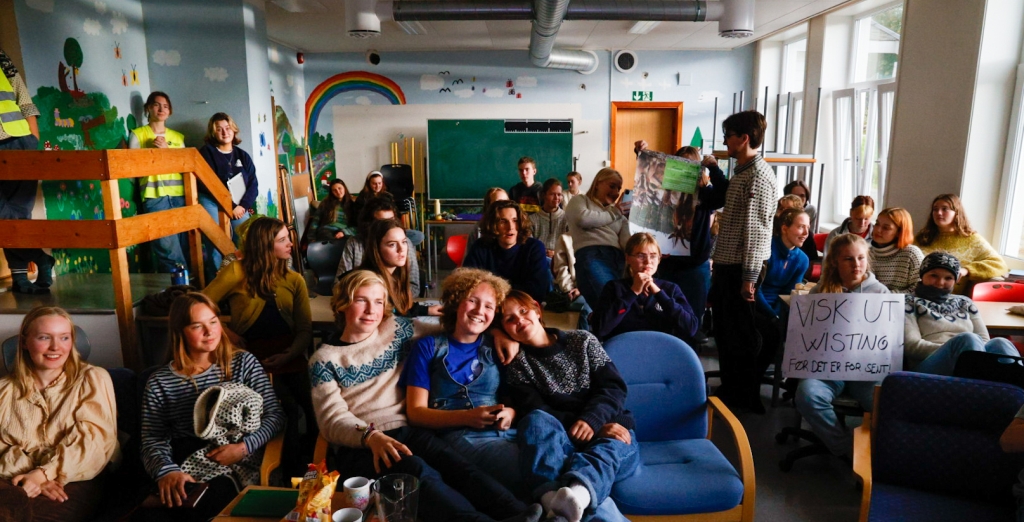
Nature and Youth arranges several events focusing on ocean sustainability and fisheries. Here from the Ocean Seminar 2022 in Volda. (Photo: Nature and Youth)
Kim Scherrer and Sara Hornborg (project partner at RISE) of the Future Fisheries project contributed to the academic program at the the Nor-Fishing exhibition.
13 October 2022
Nor-Fishing was arranged 22-26 August in Trondheim. Beyond seizing the opportunity to interact with the industry, fisher organizations, coastal municipalities, and management organizations, the two team members contributed to the academic program at the fair. At the Research Square (Forskningstorget), Kim presented the project (How can fisheries contribute more to a sustainable future?) in a special session on the Decade of Ocean Science - Ten Years of Ocean Action. Both Kim and Sara were involved in the academic conference at Nor-Fishing, which this year had the theme: Green Transition and Sustainability in Fisheries. Sara gave the keynote presentation in the session Methods for Future Management of Fisheries, focusing on future sustainability challenges like CO2 emissions and how to manage them. Kim chaired the session together with TEG alumni Fabian Zimmerman from IMR.
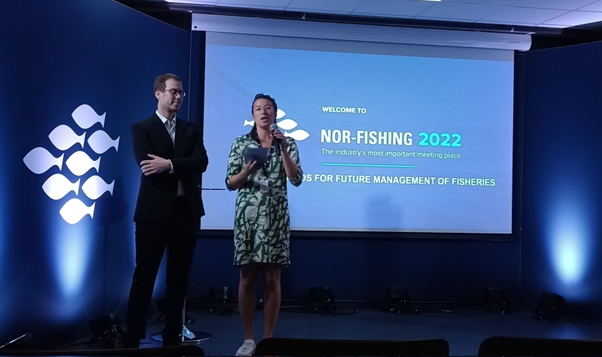
Kim on stage with Fabian Zimmermann of IMR. (Photo: Mikko Heino)
A symposium on capelin is organized in Bergen, and Tom J. Langbehn gave a plenary on Understanding the implications of the new Arctic lightscape.
11 October 2022
The conference is organized by the Institute of Marine Research on behalf of ICES and more information can be found here:
The website of the capelin symposium.
On their website is a news story about Tom’s presentation.
We are excited to welcome three new members to the Theoretical Ecology Group to work on the project How can fisheries contribute to a more sustainable future? The project is a Collaborative Project to Meet Societal and Industry-related Challenges within the thematic area Sustainable Food Systems funded by the Research Council of Norway.
4 March 2022

From left Anita Løtvedt, Alex Tidd, and Kim Scherrer. (CC0)
PhD research fellow Anita Løtvedt
My name is Anita and I just started as a PhD fellow in biological oceanography, in the project “How can fisheries contribute to a more sustainable future?” led by Katja Enberg. I grew up in a rural part of the west-coast of Norway (south of Bergen), but I’ve lived here for the majority of the last decade.
I’ve studied mathematics here at UiB and have a Master’s degree in applied and computational mathematics. My main research interests are dynamic modeling, numerical analysis, and global sensitivity analysis.
My PhD project will be part of the work package led by my main supervisor, Dag L. Aksnes, Does state-of-the-art microbial models revise primary production and trophic efficiency? and will mostly entail developing a depth-resolved minimum microbial food web model as well as analyzing the sensitivity of key model output to changes in driving forces in the model.
Postdoctoral research fellow Alex Tidd
I recently joined the University of Bergen as a researcher to work on the sustainable food systems project funded by the Norwegian Research Council. I am going to be researching underutilized fishing efficiency (and greenhouse gas emissions) and how this threatens the long-term sustainability and biodiversity of marine capture fisheries and seafood supply, including those threatened by climate change. My background and main area of research are fishing fleet dynamics and fisher behavior, and I have a wider interest in linking these processes to aquatic ecosystems. I began my career in the United Kingdom working at the Centre for the environment, fisheries, and aquaculture Science (Cefas) working on a variety of policy-orientated European Commission and UK government-funded research projects. Since I have gained international experience including working in policy at an intergovernmental organization, and within a number of academic environments.
Postdoctoral research fellow Kim Scherrer
I have just started as a postdoc with Katja Enberg as part of the Future Fisheries project. I’m from Östersund, Sweden, and did my PhD at ICTA at the Autonomous University of Barcelona, Spain. There, I focused on representing human dimensions like management, climatic shocks and employment in a global fisheries model. I’m interested in future projections for marine ecosystems, size-spectrum modelling and many other things in the interface between marine and human systems. Beyond that, I’m a keen skier, climber and hiker. In the Future Fisheries project, I will explore the potential productivity of marine fisheries and interlinkages between marine and terrestrial food production systems. Through such analyses, we hope to identify ways in which fisheries can contribute more food with less ecosystem and climate impacts.
Monday Astrid defended her Masters thesis on the trophic structure of the mesopelagic community in the Northeastern Atlantic using isotope methods. Supervisors were Eva Garcia Seoane (Institute of Marine Research) who also provided the data and lab guidance, and
Tom J. Langbehn.
13 October 2021
Professor Stein Kaartvedt of the University of Oslo was external examiner and led an enjoyable discussion with Astrid.
Her thesis bears the title Trophic structure of mesopelagic species in the Northeast Atlantic Ocean based on stable isotopes of carbon and nitrogen and a link will be provided here as soon as it is available online.

Tom, Astrid, and Eva cool down in the refreshing Bergen rain after a good discussion about Astrid’s thesis work with the examiners. (CC0)
Are you interested in developing your dream project on the ecology and evolution of macroalgae? The project is a collaboration between the research group in Marine Biodiversity and TEG where we wish to work on the adaptations of macroalgae to their seasonal environment as well as the seasonal dynamics of these prominent primary producers and foundation species.
13 September 2021
The position is a three to four year postdoc opportunity in coastal ecology and part of a large pool of openings at the University of Bergen within the programme Shaping European Research Leaders for Marine Sustainability (SEAS). Application deadline is 31 October, but please get in touch with professor Kjersti Sjøtun and professor Øystein Varpe to discuss your ideas before that. SEAS is part of an EU mobility programme for international candidates moving to Norway.
Links to further information:
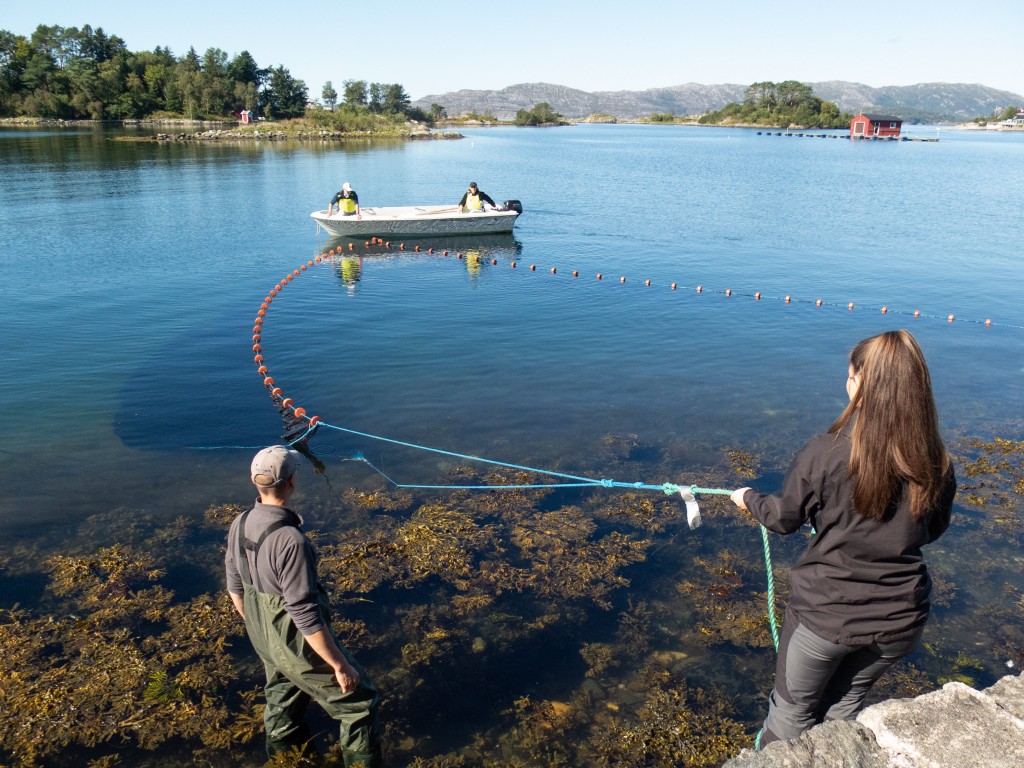
Plentiful fieldwork opportunities for the project such as at the Marine Biological Station Espegrend. (Photo: Øystein Varpe).
Our new project asking how fisheries can contribute more to a sustainable future is hiring new people to investigate the contribution of fisheries to sustainable food systems, refine estimates of primary production and trophic efficiencies, and to map peoples’ values towards nature and food production across sea and land.
28 August 2021
The project is funded by the Research Council of Norway, as a Collaborative Project to Meet Societal and Industry-related Challenges within the thematic area Sustainable Food Systems. The project is interdisciplinary across biological oceanography, marine ecology, and psychology, with strong involvement of the seafood industry (Fiskebåt), a conservationist NGO (Nature and Youth), and Norway’s government agency advising and implementing management of marine living resources (Directorate of Fisheries). The project duration is four years starting from November 2021. We are now recruiting four early career researchers, two PhD-candidates and two postdocs. You can read more about the project at the home page. DEADLINE for applications is 3 October 2021, and here are links to the application portal:
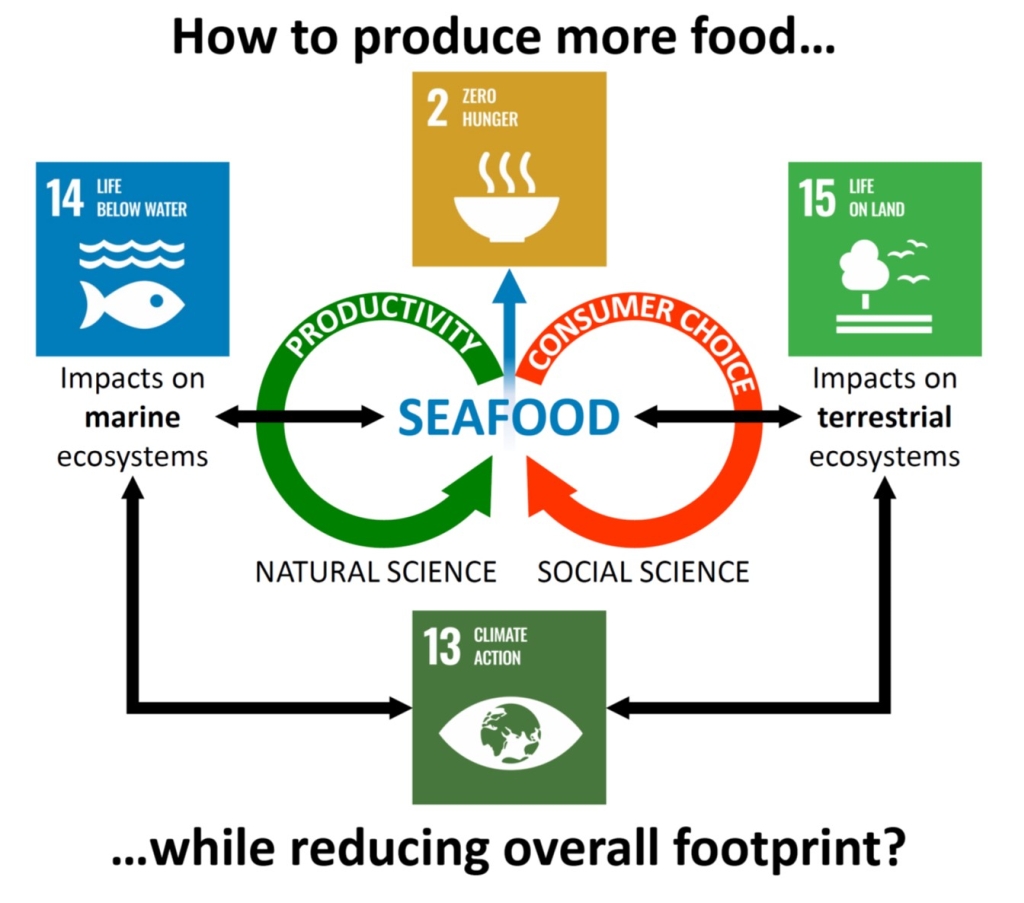
That Andrea Campos-Candela and Rachael Morgan begin their postdocs marks the start of our project on effects of hypoxia for tropical coral reefs and the fish that live there.
5 August 2021
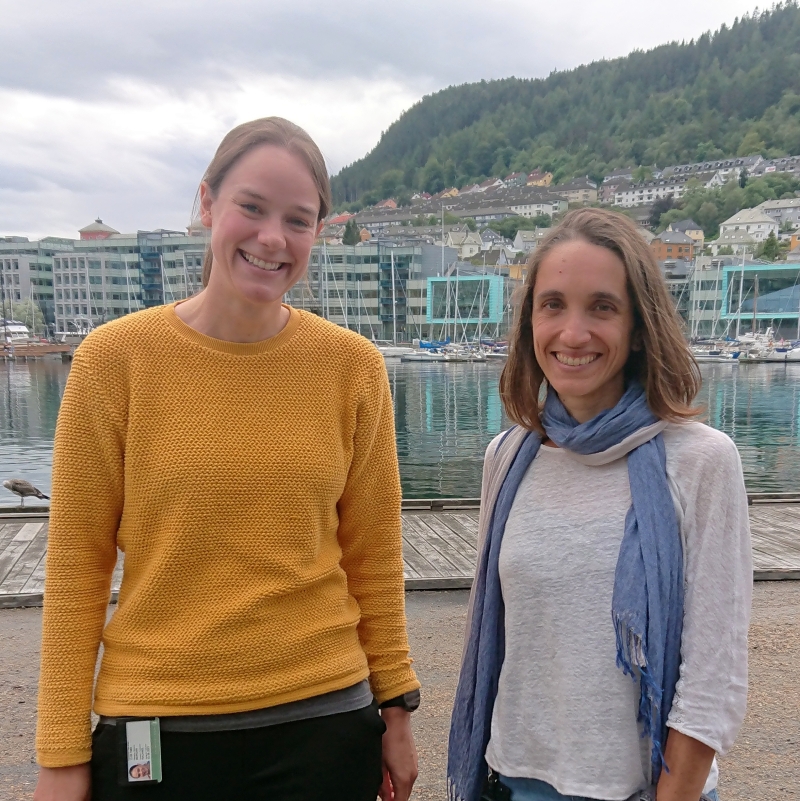
Rachael (left) and Andrea (right) have just settled at the University of Bergen and are very excited about getting started with the project and to sharing the experience with all of you.
Good news: In the heat of the night has started! Rebecca E. Holt at the University of Oslo will also work on the project, and Fredrik Jutfelt at NTNU in Trondheim is national collaborator.
Internationally, Timothy D. Clark (Deakin University, Australia) will be sparring partner on fish physiology and fieldwork, while Adriana Humanes (Newcastle University, UK) and Julia Strahl (Carl von Ossietzky University of Oldenburg & Helmholtz-Institute for Functional Marine Biodiversity, Oldenburg, Germany) have invaluable expertise and experience with corals. Adriana and Julia are both associated with the CoralAssist Lab at Newcastle University.
This week, the
ASLO 2021 Aquatic Sciences Meeting
is taking place in virtual Mallorca. Anne Deininger (NIVA), Anders F. Opdal (TEG), Dag O. Hessen (UiO), and Helene Frigstad (NIVA) chaired session SS47 Freshwater browning and coastal darkening.
24 June 2021
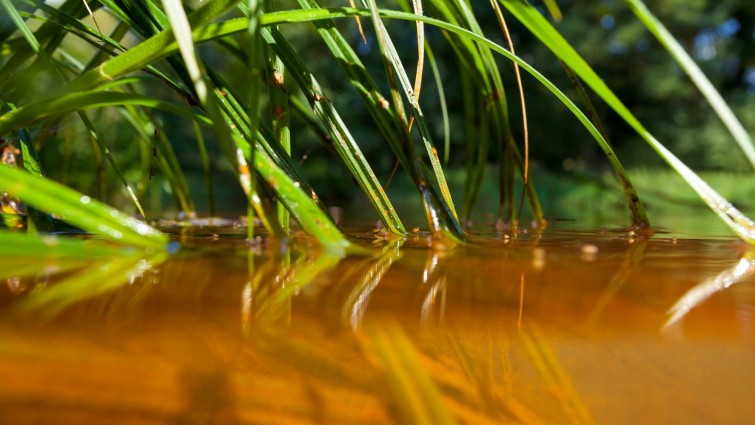
Das Wasser einiger Fjorde an der Westküste Norwegens wird immer brauner (Credit: picture alliance / zb | Andreas Franke)
Prior to the conference, Anne and Anders were interviewed by the German radio braodcaster Deutsclandfunk, and their daily science program Forschung aktuell. Finally, we made it to German radio! Dubbed to German, natürlich. Listen to the whole interview here.
Seit einigen Jahren werden die Seen und Flüsse in Skandinavien immer dunkler. Inzwischen sind auch die Küstengewässer betroffen. Grund dafür ist nicht Umweltverschmutzung, sondern im Gegenteil: Ein Faktor ist sauberere Luft. Die dunkle Farbe bringt jedoch ganze Ökosysteme durcheinander.
Today Anna Ejsmond defended her PhD degree on reproductive timing in eider ducks, online in Zoom. Anna was a student at UNIS on Svalbard and co-supervised from TEG in Bergen.
16 June 2021
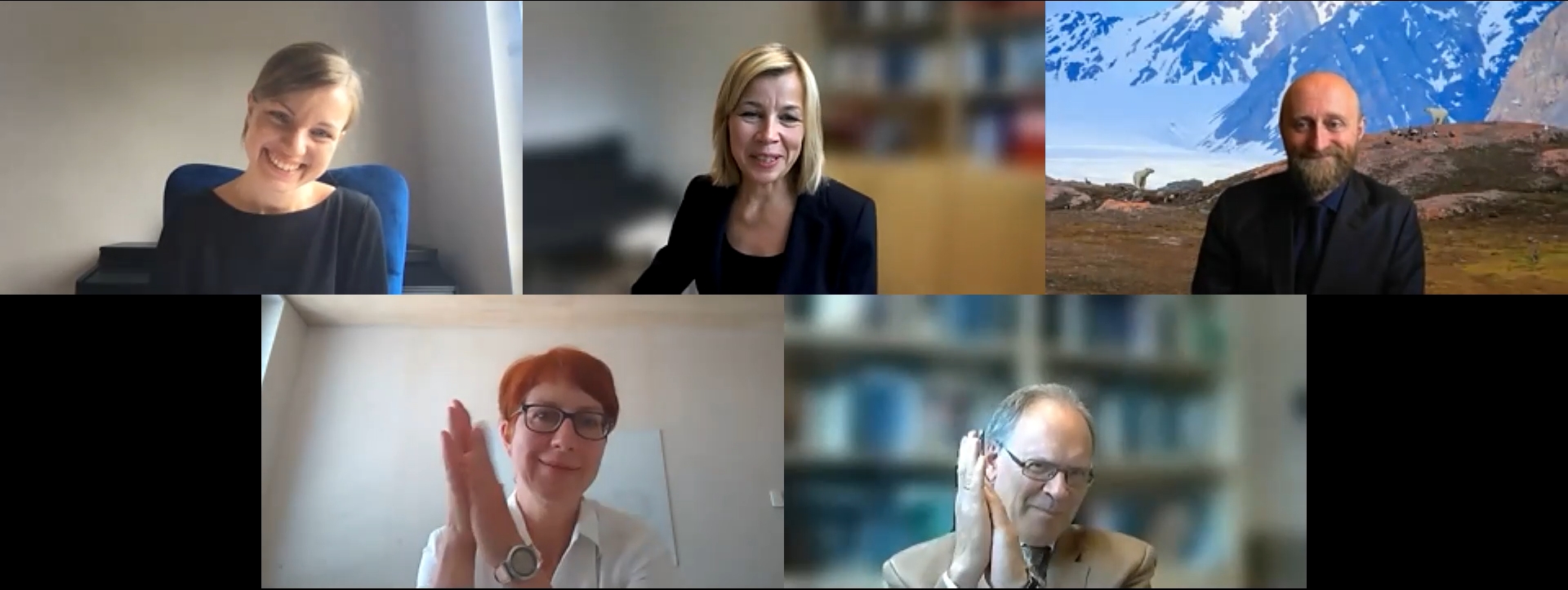
The discussions between Anna (top left) and her opponents Silke Bauer (bottom left) Swiss Institute of Ornithology) and Sveinn Are Hanssen (top right, NINA, Tromsø) were lively and thoughtful. Jarl Giske (bottom right) was the internal leader of the evaluation committee and Sigrunn Eliassen (centre, top) chaired the dissertation ceremony.
Anna’s PhD thesis consisted of two chapters using a state-dependent models to analyse reproductive timing in eider ducks on Svalbard, an empirical chapter of observations of eiders, and a theoretical paper on strategies for growth and reproduction in freshwater crustaceans. Superviser at UNIS was Mads Forchhammer and Christian Jørgensen from TEG was supervisor from UiB.
For two weeks in June, Katja Enberg and Gabriella Ljungström from TEG have been leading the course Sustainable development of life below water at Bergen Summer Research School.
14 June 2021
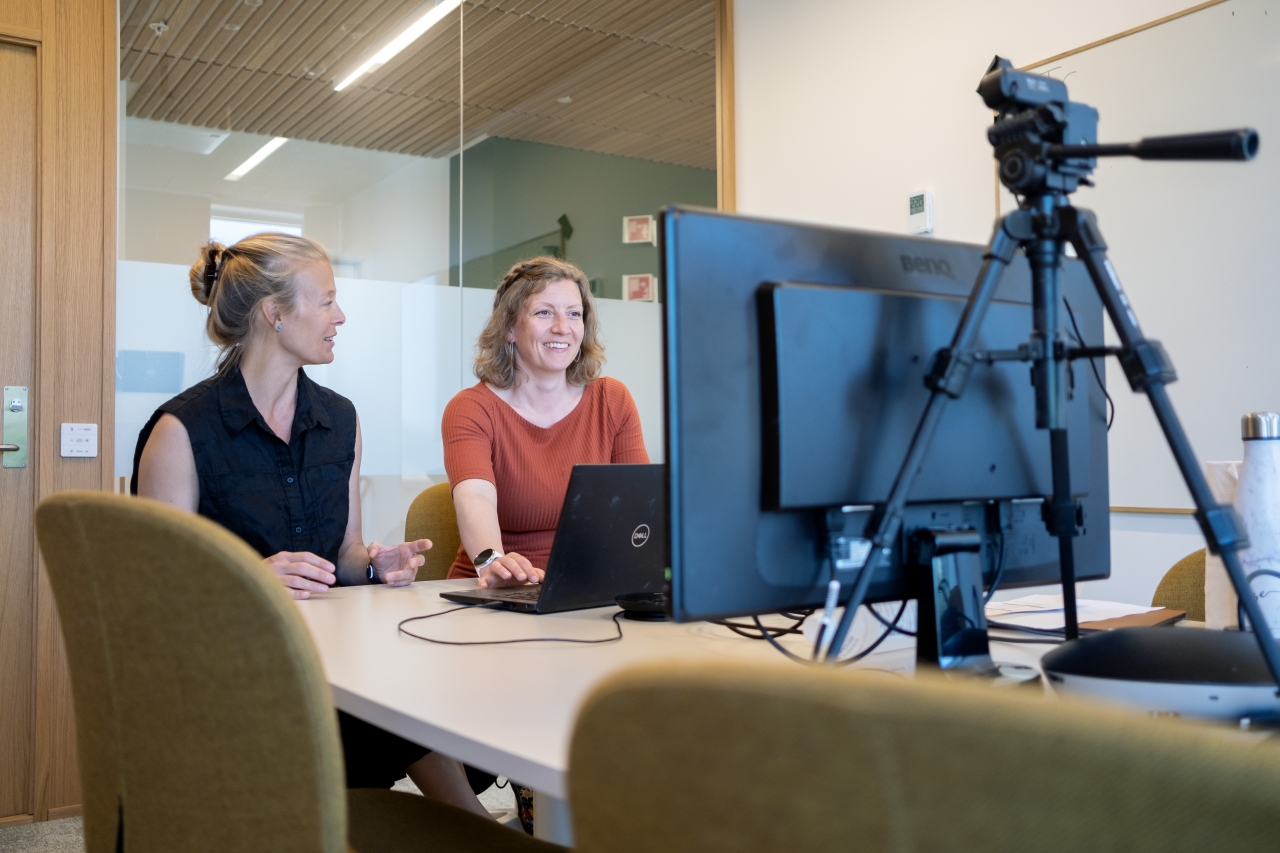
Gabriella Ljungström and Katja Enberg in the digital course headquarter at Alrek, Bergen. (Photo: Eivind Senneset/UiB.)
Bergen Summer Research School is an annual event and normally students from all over the world gather in Bergen to participate. This year and last, the school has been a fully digital event, which has worked out surprisingly well considering the different time zones and varying quality of internet connection of the 127 participating students. This year the overarching theme of the summer research school is “Science and Society towards the Sustainable Development Goals” and it offers six courses that focus on key global challenges. In 2021, Katja is the scientific director for the summer school.
The course Sustainable development of life below water sets focus on the UN Sustainable Development Goal 14: Life below water, which aims at “conserving and sustainably using the oceans, seas and marine resources for sustainable development”, and has 10 specified targets related to marine pollution and conservation, sustainable fisheries, and global change. In the course, built on active learning methods, the students acquire knowledge and skills related to science, policy, and society necessary for contributing towards sustainable development of life below water.
More about the Bergen Summer Research School can be found here:
Bergen Summer Research School web pages
UiB news: Gathering PhD candidates from 45 countries around the SDGs
Species distribution models rely heavily on temperature but will get it wrong in boreal and Arctic regions if they ignore seasonality in light. This is the conclusion in a recent article by postdocs Gabriella Ljungström and Tom J. Langbehn, published in Nature Climate Change.
13 May 2021
Gabriella and Tom each had a model for bioenergetics in seasonal environments developed during their PhDs, and combined these to investigate the influence of seasons.
Gabriella’s model focused on Atlantic herring and found that overwintering was the main energetic hurdle, and that warming would make energy stores burn faster during the dark and food-free winter.
Tom’s model was for mesopelagic fishes that inhabit the ocean twilight zone, and they struggle during the midnight sun when zooplankton remain near the surface where predators are abundant. With ocean warming, the mesopelagic fish would need more food, but neither predators nor light would disappear. Again, warming would enhance the latitudinal barrier.
Read the interview with Gabriella and Tom at the University web pages [In Norwegian].
Gabriella has written a behind-the-paper blog post on the Nature website.
This video explains their main findings:
And you can read the full paper here:
Marc Mangel has together with the Johns Hopkins University Applied Physics Laboratory written a report on how to look beyond test results to estimate actual incidence rate and public health risk of various group sizes.
5 May 2021
The report is written for individuals tasked with providing analytical advice to policymakers.
Marc Mangel has been a collaborator of TEG since the 1990s, first with Jarl and then with almost everyone, and adjunct professor in our group for the last ten years. Today he is turning 70 - congratulations!
10 March 2021

This picture shows Marc in his favourite activity: discussion and conceptualization. (Photo: Phil Levin.)
Jarl Giske struggled with modelling animal behaviour from life history theory in his PhD and discovered state-dependent optimization just before he finished. A month after the defence in 1990 he met Marc who taught him Dynamic Programming and it all fell into place. The two of them have been close research allies and friends ever since, and the relationship has grown so Marc is now a dear friend to many in TEG and a valued mentor to all of us. Over the years Marc has hosted research visits not only by Jarl but also Rune Rosland, Øyvind Fiksen, Sigrunn Eliassen, Christian Jørgensen, Katja Enberg, and Fabian Zimmermann. As adjunct professor the last ten years Marc has visited our group annually to engage with everyone, which has been particularly motivating for our PhD students and postdocs. Yesterday, we celebrated with him in Zoom and with bubbles as he turns 70 today, congratulations!
Although Marc is retiring, at least as a formality, he shows few signs of slowing down his research activities. We are proud that Marc chooses to be closely associated with us also in the next phase and will use Professor Emeritus at University of Bergen as his active title. And we are patiently waiting for the post-covid times when we finally can meet in person again for discussions and brainstorming!
Hakai Magazine published a feature article on coastal water darkening by Doug Johnson: The environmental threat you’ve never heard of.
10 February 2021
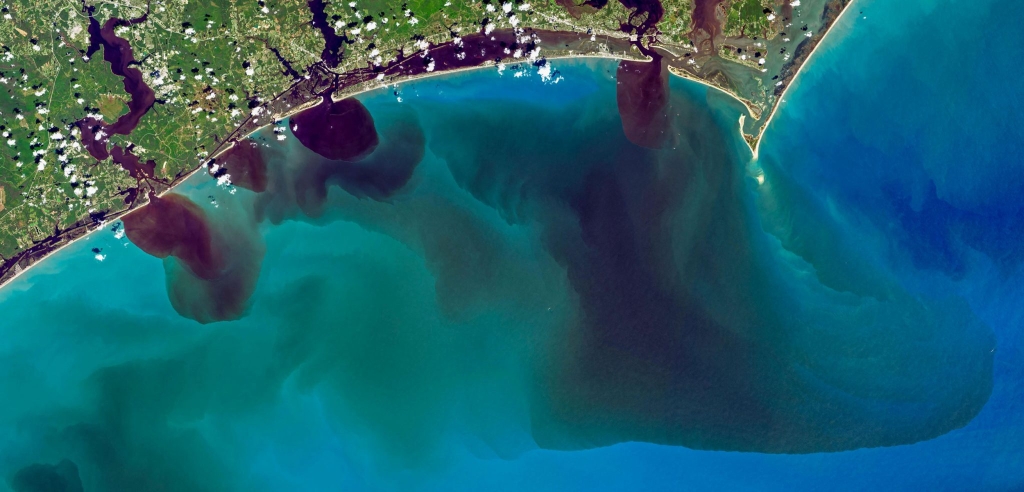
Brown freshwater draining from rivers to the coastal waters.( Photo: LWM/NASA/LANDSAT/Alamy Stock Photo.)
The article features interviews with Anders F. Opdal from the Theoretical Ecolgoy Group, in addition to Maren Striebel and Oliver Zielinski in The Coastal Water Darkening Project, and Amanda Poste from NINA. The story revolves around findings from a recent paper by Poste, Maeve McGovern, and colleagues at NIVA and University of Oslo. The magazine article is a bit doom-and-gloom, but the researchers did manage to get through a few moderating points.
All in all, it’s difficult to pin down any specific consequences of coastal darkening, says Opdal. [...] It’s a tricky thing to study, with many moving parts.
You can read the whole article here:
Hakai Magazine: The environmental threat you’ve never heard of
All of TEG is proud of Sigrunn Eliassen, who will receive the Thon Foundation's National Teaching Prize for her outstanding contributions to higher education within science and technology.
15 January 2021
When Olav Thon donated his fortune to a charity, one of the aims was to promote teaching within science, technology, and medicine in Norway because it cleverly benefits young poeple in education as well as the country as a whole. A main pillar is therefore the Thon Foundation National Teaching Award, and this year Sigrunn Eliassen will be one of three people to receive it.
You can read more about it here:
Khrono - Milliondryss fra Thon til fremragende undervisere [In Norwegian]
Olav Thon Stiftelsen - Årets vinnere 2021 [In Norwegian]
This is the first extensive review on the subject, and includes several findings from the current project From terrestrial greening to coastal darkening as well as earlier work by Dag L. Aksnes.
10 November 2020
Our colleagues at NIVA recently published a national review on coastal darkening research:
Increased light attenuation in Norwegian coastal waters - A literature review.
The report, lead authored by Helene Frigstad, was also transformed into a research article published in Frontiers in Marine Science:
Influence of Riverine Input on Norwegian Coastal Systems.
The report and article concludes that human induced changes on land are the primary driver of coastal darkening.

From the report cover. (Photo: Anne Deininger, NIVA)
The Norwegian national broadcasting company (NRK) wrote a short news story about our project Nytt miljøproblem i Norge: Klimaendringer gjør havet mørkere [In Norwegian]. Anders F. Opdal and Anders F. Opdal at TEG were interviewed.
31 October 2020

Heavily brown coloured freshwater in a Swedish river.(Photo: Øyvind Fiksen.)
Despite the title, neither Opdal nor Aksnes stated that coastal darkening was an environmental problem.
Mørkere hav kan få konsekvenser for småfisken, ifølge professor. Nå skal forskere bruke de neste fire årene på å finne ut om det er en krise for økosystemet.
The article was followed up by a radio interview on the local news program Hordaland i dag. (Scroll to the header Kvifor blir sjøen mørkare or 1:09:45 into the timeline.)
Digital Life Norway features on their web pages the modelling done by Camilla Jensen and Jacqueline Weidnerin during their PhDs.
30 September 2020
The full story can be read here:
https://digitallifenorway.org/blogg/does-the-hormone-system-contain-an-ability-to-plan-for-the-future
Jacqueline Weidner defended her thesis successfully 29 June 2020.
25 September 2020
Her first paper was a model of the hormone system involved in appetite, feeding, and growth in juvenile fish, with a focus on how the hormone system could control the organism with maximum juvenile survival probability as a goal function.
Her second paper was how this control can work in stochastic food environments, where the fitness value of future-anticipatory control mechanisms by the hormone system emerge from the model.
The third paper is an application of the model to understand the Pace-of-life syndrome (POLS).
Dag O. Hessen of University of Oslo and Dag L. Aksnes from TEG appear on the Norwegian radio program Ekko discussing the causes and consequences of darker coastal waters.
11 September 2020
The full radio program [In Norwegian] is available here:
https://radio.nrk.no/serie/ekko/sesong/202009/MDFP02018320#t=27m2s
(select the header Havet blir mørkere or scroll to 27:02 on the timeline).
Hva i all verden er det som skjer, undrer jeg. Hva er det som slukker lyset i fjordene og havet? [...]. Det viser seg at Dag Hessen er på saken.
After a successful and fully digital trial lecture, Camilla was already experienced in the art of online presentations when it was time to defend her PhD thesis. And of course, it went smooth. Congratulations as PhD, Dr Jensen!
28 April 2020
While the discussion with opponents took place in Zoom, the audience had to follow the defence livestreamed to YouTube. Opponents Jane Behrens from DTU Aqua in Copenhagen and Knut Wiik Vollset at NORCE in Bergen led an exciting and interesting discussion with Camilla as she defended her thesis Hormone strategies as a key for understanding life history tradeoffs in fish.
It was bizarrely ironic that Camilla, who has such a warm heart for parasites, had to cancel her PhD party because of a pathogen, and that her thesis work on digital fish had to be defended digitally. But true to how we have learned to know Camilla, she of course took the whole challenge with a big smile!
Gabriella Ljungström defended her PhD thesis online on YouTube the first day Norway’s universities were closed down because of the Corona pandemic.
30 March 2020
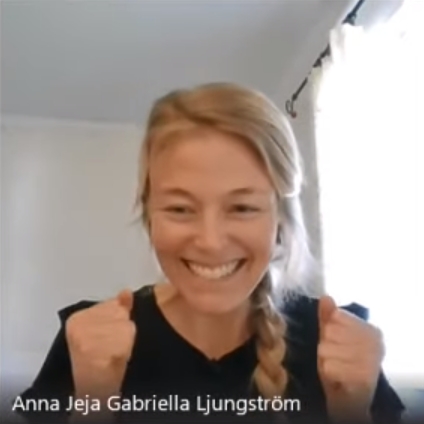
With a bit of planning, even unforeseen events at Friday 13th can eventually have a positive outcome. Congratulations, Dr. Ljungström!
First it became clear that the opponents were prevented from travelling to Bergen because of COVID-19 restrictions. Then local regulations were announced that prohibited crowds, so the defence could take place with only the committee, supervisors, and a few more present. The night before the defence all university buildings in Norway were shut down, at the University of Bergen with eight minutes notice. The defence was all the time planned for Friday 13th, but when even the social afterparty had to be cancelled, wasn’t this too much?
Luckily there are tools for electronic communication. The opponents, Elvira Poloczanska (Alfred-Wegener-Institut, Bremerhaven, Germany) and Asbjørn Vøllestad (University of Oslo) were sporty enough to complete their job online with live-streaming. So while Gabriella and her opponents discussed on Skype, the audience could view the whole thing on YouTube from home.
Supervisor Christian Jørgensen had frantically packed away Lego to convert a children’s room into an academic TV-studio, but his son convincingly suggested one Luke Skywalker mini-figure should remain in the background to help with the force should Gabbi need it.
The defence went well, and judging from the series of incoming telephone calls afterwards family and friends had indeed taken part and could share her happiness.
And the scientific topic? It was about bioenergetics, climate, and life history evolution in planktivore fishes.

The opponents Elvira Poloczanska and Asbjørn Vøllestad challenged the candidate with many thoughtful questions. After some time the conversation took on a life of its own, and intensity and focus was indistinguishable from a regular PhD defence as it would have been if everyone were together in the same room.
Being the first digital PhD defence in Norway during the COVID-19, the local UiB newspaper wrote a story that was republished by Khrono, the national university newspaper. You can read them (in Norwegian) here:
Tom J. Langbehn is chairing a session on Biomass, biodiversity, and ecosystem services in the mesopelagic zone at the ICES Annual Science Conference in Copenhagen in September. Submission deadline is 11 March 2020.
21 January 2020
Here is the theme session description:
Biomass, biodiversity, and ecosystem services in the mesopelagic zone
Recent acoustic estimates suggest that the mesopelagic zone might harbour 10,000 metric tonnes of unexploited fish biomass, far exceeding global fisheries catches in the epipelagic zone. This has attracted renewed attention to the utilisation of mesopelagic resources. With the global demand for food projected to increase by 60% by 2050, the sustainable exploitation of mesopelagic resources represents a potential game changer.
The fundamental biological knowledge needed for sustainable resource management and an understanding of the vital role of mesopelagic communities in global processes, e.g. biogeochemical cycling, is however lacking. Therefore, renewed research efforts on this largely unexplored and unexplained ocean realm are timely.
This theme session provides an opportunity to review and report on the extensive ongoing international activities in mesopelagic research. Empiricists, modelers, experimentalists, and theoreticians are invited to present studies, share findings from recent cruises, and exchange ideas on the structure, function, and change of mesopelagic ecosystems and interactions with other ocean realms.
Contributions are invited that relate to the mesopelagic zone and:
Specific examples of interest include:
View the session at the ICES webpages:
https://www.ices.dk/news-and-events/asc/ASC2020/Pages/Theme-session-B.aspx
We currently have an open PhD position in evolutionary parasitology here in Bergen, within the project Anthropogenic Parasite Evolution (ParAnthropE) funded by the Research Council of Norway.
15 December 2019
The PhD will be supervised by Adèle Mennerat. Application deadline was 22 December 2019.
The full advertisement can be found here:
https://www.jobbnorge.no/en/available-jobs/job/179079/phd-position-in-evolutionary-parasitology
Steinar Trengereid started his Master project this autumn in the salmon lice lab with supervisor Adèle Mennerat.
14 December 2019
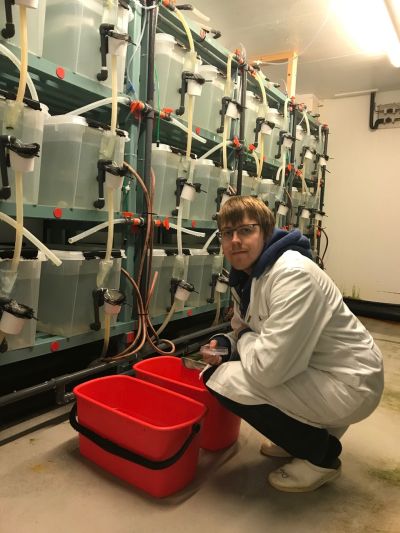
Steinar in the lab.
Steinar is experimentally investigating the links between sex ratio and mating behaviour in the ectoparasitic salmon louse, Lepeiophteirus salmonis.
The coastal water has become darker over the last century. In an interview at forskning.no, Anders F. Opdal explains the phenomenon and its causes and consequences.
23 September 2019

A phytoplankton bloom in the North Sea in spring 2018. (Photo: NASA.)
Read the story at forskning.no here:
forskning.no: Mørkere vann forsinker algenes årlige vårfest i Nordsjøen
The magazine article, by Øystein Rygg Haanes, focuses on the potential effect of darkening on the annual phytoplankton spring bloom.
Påstår bestefaren din at vannet langs kysten var klarere da han var ung? Det trenger slett ikke være gubbete glorifisering av gode, gamle dager. Ny forskning viser at Nordsjøen var klarere for hundre år siden. En av årsakene til formørkningen er økt plantevekst på land, som fører til at mer fargestoff – nedbrutt organisk materiale – finner veien ut i havet.
The interview is based on this recent paper:
In their accepted paper in Estuarine Coastal and Shelf Science, Dag L. Aksnes, Jan Aure, Per-Otto Johansen, Geir H. Johnsen, and Anne Gro Vea Salvanes provide evidence that ocean warming has caused a multi-decadal oxygen decline in Norwegian fjords.
19 September 2019

Observed and simulated oxygen content of the Masfjorden basin.
The open ocean and many coastal waters around the world have lost oxygen over the past 50 years. Eutrophication, involving human-induced discharges of nutrients and organic material, is a major cause for oxygen declines in coastal waters. For the ocean interior, reduced ventilation is likely the main cause. However, this has been difficult to verify because the processes involved in ocean overturning are slow. Ventilation of deep fjord basins is much faster, and the authors show how reduced vertical water exchange has caused long-term oxygen decline.
The study demonstrates that the oxygen content of a deep fjord, Masfjorden, has dropped over the last four decades. In the same period, the temperature of the oxygen-rich North Atlantic Water (NAW), which ventilates Masfjorden as well as other fjords, has increased with about 1ºC. Because of this warming, NAW has become less dense, and therefore less able to sink and thereby bring new oxygen into the basin of Masfjorden. This suggests that deep Norwegian fjords are prone to a warming-induced decrease in ventilation and associated deoxygenation - similar to the hypothesis for oxygen decline of the ocean interior. The authors expect further oxygen decline if NAW becomes less dense because of warming, but an oxygen increase if density should increase. Potential implications of fjord deoxygenation is altered biodiversity involving shift from mesopelagic fishes to jellyfish. As demonstrated in the study, deoxygenation reduces the holding capacity for fish farming. This might have socioeconomic implications as fjords and coastal areas are currently a main asset in Norwegian fish farming.
A recently accepted article in Marine Ecology progress Series by Stein Kaartvedt, Anders Røstad, Anders F. Opdal, and Dag L. Aksnes shows how a diving ROV with an attached light source trigger dichotomous responses in the mesopelagic fish assemblage.
17 August 2019
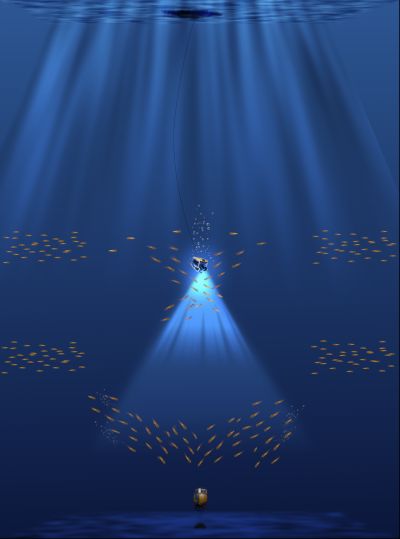
A diving ROV equipped with LED lamps was herding mesopelagic fish down to the bottom, but nearby fish were attracted to the light.
The authors show how a diving ROV equipped with LED lamps was herding mesopelagic fish down to the bottom at 700 m. The event was monitored by shipborne and bottom-mounted echosounders as well as video footage from the ROV, and indicated that the fish' responses to light included both repulsion and attraction. By constructing an individual-based model, the authors were able to reproduce the herding event by assuming a dichotomous response to light, where fish close to the light source were attracted while fish further away were repulsed. They hypothesize that attraction is associated with the artificial light acting as a point source (beam light), while the repulsion is associated with the artificial light acting as diffuse light.
In their newly accepted paper in Global Change Biology), Anders F. Opdal, Christian Lindemann, and Dag L. Aksnes provide evidence suggesting that the centennial decrease in North sea water clarity may have delayed the phytoplankton spring bloom by up to 3 weeks compared to the early 1900s. This delay stands in contrast to the earlier bloom onset typically expected from global warming.
16 August 2019
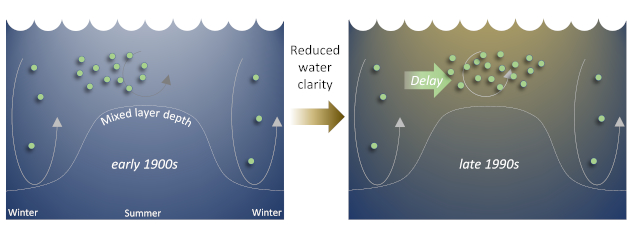
Predicted phytoplankton response to increased non-chlorophyll light attenuation.
The study utilized a 100-year time series of Secchi disk depth along with various proxies for phytoplankton concentrations. The authors conclude that factors other than phytoplankton, such as increased dissolved organic matter of terrestrial origin, also known as browning, has caused the observed reduction in North Sea water clarity. Through several numerical simulations of water columns, the authors find that the observed coastal water darkening would have delayed the spring bloom by up to three weeks since the early 1900s. In the future, climate warming is expected to further increase browning in lakes and rivers due to increases in terrestrial greening, ultimately reducing water clarity in coastal areas where freshwater drains. However, increased ocean temperature is also suggested to advance the spring phytoplankton bloom due to earlier shoaling of the mixed layer. These contrasting responses highlight the importance of including water transparency in analyses of phytoplankton phenology and primary production.
Tom Langbehn explains how the midnight sun makes polar seas inhabitable for mesopelagic fish.
29 July 2019
The article can be found at uib.no and has been picked up by Kyst og Fjord.
In a new paper in Frontiers in Ecology and Evolution, Sergey Budaev, Jarl Giske, and colleagues in TEG argue that an animal is a prediction machine that uses its brain and nervous system to model how one or several potential choices will be felt by the body before the decision is made.
22 May 2019
The fundamental state to consider is therefore not stomach contents, fat reserves, or body mass per se, but a state of its mind: the global organismic state. The animal's subjective internal model can, via control of the nervous system, set the animal in a mental state that will dominate many aspects of its cognition and behavior, including decision-making.
Today Tom J. Langbehn defended his PhD Thesis with the title Light and visual foraging in the pelagic: Opportunities and constraints along gradients of seasonality. His focus has been how the increasing seasonality at higher latitudes enforce ever stricter constraints on annual cycles of marine organisms.
30 April 2019
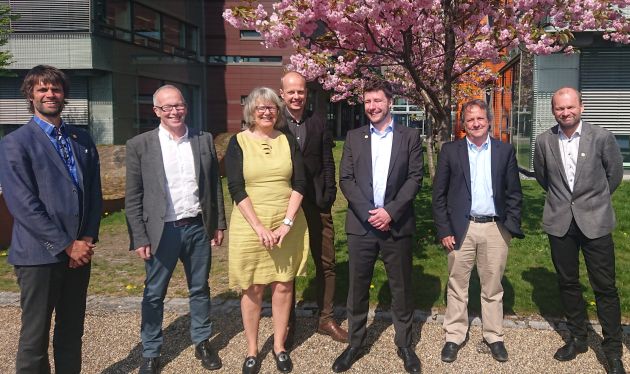
From left to right: supervisor Christian Jørgensen, opponent Michael T. Burrows, internal committee leader Anne Gro Vea Salvanes, supervisor Øystein Varpe, a happy and smiling candidate, opponent Xabier Irigoien, and supervisor Øyvind Fiksen.
Tom has had a particular focus on how seasonality in light affects visual foragers. At high latitudes, the polar night and midnight sun are challenging for the many marine organisms that perform diel vertical migrations, migrating up and down in the water column on a daily basis to balance foraging opportunities and predation risk. For mesopelagic fish, the main bottleneck is midnight sun, as they then are prevented from migrating to the productive surface layers in the protection of darkness, over time causing depleted energy reserves and risky behaviours. Were the sea ice to disappear in a warming climate, then visual feeders such as planktivorous fish will have much higher expected foraging success.
Do jellyfish matter? A new study recently published in Scientific Reports suggests perhaps not as much as we thought.
1 March 2019

An overview of the hypotheses tested.
Long-standing hypotheses regarding the negative effects of jellyfish on small pelagic fish recruitment or as an important competitor for their crustacean zooplankton prey are difficult to test against data. Authors Anders F. Opdal and Dag L. Aksnes at UiB have, together with colleagues in the US, Bulgaria, and South Africa, collected historic and recent data from the Bering Sea, the California Current, the Black Sea, and the Benguela to test a series of jellyfish-related hypotheses at the ecosystem level. By calculating the energy requirements of both fish and jellyfish, they find that although jellyfish in many areas exceed the biomass of fish, their energy requirements are low, and their energetic footprint moderate. In addition, they find little signs of fish biomass, or their crustacean zooplankton prey, being influenced by jellyfish biomass. They conclude that the best available time-series data do not suggest that jellyfish are outcompeting, or have replaced, small pelagic fish on a regional scale in any of the four investigated ecosystems.
9 January 2019
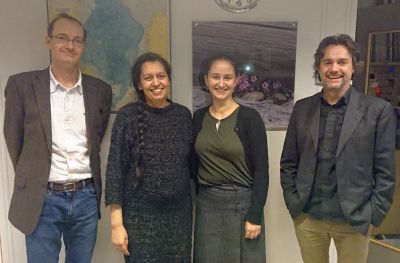
From left: UiB representative in the committee professor Mikko Heino, a very happy Nadia Fouzai, and external opponents Irja Ratikainen (NTNU, Norway) and Peter Grønkjær (Aarhus University, Denmark).
The opponents Peter Grønkjær (Aarhus University, Denmark) and Irja Ratikainen (NTNU, Trondheim, Norway) provided stimulating and thoughtful discussions. Supervisors have been Øyvind Fiksen, Anders F. Opdal, and Christian Jørgensen.
Nadia was part of the NorMER network funded by the Nordic countries through Nordforsk.
In December 2018, Marc Mangel was awarded the Outstanding Achievement Award from the American Institute of Fishery Research Biologists (AIFRB).
12 December 2018
AIRFB is an association to establish and maintain high professional standards of recognition of achievement and competence. The President of AIRFR emphasizes that the scientific merit and broad-reaching impacts of Marc’s research exemplify the fishery science that AIFRB promotes and recognizes.
Congratulations Marc! We are very pleased to have you as adjunct professor, and we see that you play an important role in the formation of young researchers in the Theoretical Ecology Group!
Large zooplankton avoid predation from fish by sinking into deep and dark depths of the ocean. However, over sea summits and banks they are blocked from sinking very deep by the bottom already at depths that are quite illuminated during daytime. This gives visual foragers such as fish an advantage, and they are more likely to find food over banks than over deep trenches.
23 November 2018
In a new study published in Limnology and Oceanography, Johanna Aarflot, Øyvind Fiksen, Anders F. Opdal, Dag L. Aksnes, and others show that large zooplankton in the Barents Sea are generally distributed much closer to the surface in shallower areas. The consequence of this is that large zooplankton are exposed to several orders of magnitude more light during daytime over the 100 m deep banks compared to where the bottom depth is 300 meter or more. A planktivore fish therefore encounters 400 times more prey above the bank, even if prey abundance is the same!
News articles (in Norwegian):
Tom J. Langbehn, PhD student with us and part of the European training Network MArmaED, presented two chapters of his PhD at the 2018 ICES Annual Science Conference in Hamburg.
4 October 2018
As part of the Theme session D on the Nordic Seas and the Arctic, he highlighted published work (see reference below))quantifying how more light as sea ice declines will boost visual search in pelagic fish. His second talk, in Theme session A on mesopelagic ecosystems, quantified how seasons, in particular in light, may limit the poleward distribution of mesopelagic fish. It was for this talk he received the Best Presentation Award. Congratulations!
Johanna Myrseth Aarflot is participating in Researcher Grand Prix, with a popularized version of her research on tiny copepods and their enormous role in the oceans.
14 September 2018
The Institute of Marine Research has interviewed her about her research and her way towards becoming a biologist. You can read the full interview here [in Norwegian]:
https://www.hi.no/hi/nyheter/2018/september/ho-forskar-pa-verdas-sterkaste-dyr
Julianne Netteland defended her MSc thesis on 31 August. In her thesis work, she studied the physics of light and vision in relation to dawn song.
31 August 2018
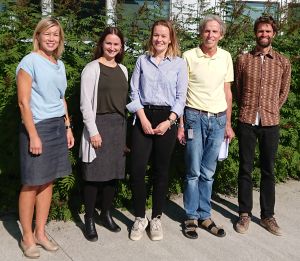
Julianne, supervisors, and examiners. From left: Sigrunn Eliassen (supervisor), Irja Ratikainen (examiner, NTNU), Julianne Netteland, Svein Rune Erga (internal examiner, BIO), Christian Jørgensen (supervisor).
In her thesis, entitled Predation risk at dawn: How changing light and birds' traits affect the temporal risk landscape during sunrise, she goes on to identify numerous trade-offs that affect vision, foraging efficiency, and risk of being encountered by predators throughout the dynamic light environment around sunrise.
The Digital Life Norway network is fostering cross-disciplinary studies based in biotechnology, and interviewed several of their projects related to aquaculture, among them our Aha project which aims to model cognition in fish.
2 August 2018
The interview can be read here: Bli med på en digital fisketur (https://www.nmbu.no/fakultet/vet/aktuelt/node/34795).
Researcher Adèle Mennerat of the Theoretical Ecology Group is sharing her views on the future of parasitology at the University of Bergen website.
23 March 2018
I am frustrated that we know so little, says Adèle Mennerat. We know that the global human impact on ecosystems is enormous, and is not limited to climate change. For parasites perhaps the biggest change lies in how we humans are modifying the availability of their hosts, she continues.
You can read the full interview here:
The future of parasitology
(http://www.uib.no/en/matnat/116317/future-parasitology).
How can the essential properties of community structure and ecosystem functioning be captured from a limited number of traits in organisms? 120 researchers from 31 nations met over four days at Solstrand to answer this question.
4 September 2017
Ecosystems are complex machineries and our ability to predict how changing drivers and environmental forcing influence them are limited. One way to represent and understand organisms, communities and ecosystems is to think in terms of specific traits, not species, and how the dominant traits appear in an evolutionary or ecological process from fundamental trade-offs between alternative traits. If we can identify the trade-offs between traits, and the trade-offs with the environment, we may have a tool for predicting trait distributions in nature or from given environmental perturbations.
Marine ecologists and oceanographers have over the last decade turned to trait-based approaches to develop models and to understand ocean communities. The third workshop on trait-based approaches to ocean life was held in Solstrand, outside Bergen, Norway during 20-23rd of August. The earlier meetings in 2013 (Copenhagen) and 2015 (New Hampshire) set the stage for this arena as a key meeting place for researchers working in this direction. This year, 120 researchers attended the workshop, covering a wide range of ecosystems from reefs to pelagic microbes.
The trait-based approach has deeper roots in terrestrial ecology, and the workshops have always focused on bringing in perspectives from general ecology. The first keynote this year was Oswald Schmitz, from Yale University. His talk was on the evolutionary ecology of ecosystem functioning - with examples on how behavioural plasticity in grazers in response to fear from specific predators can shift grazing pressure, plant communities and nutrient budgets in the soil. The couplings between ecology and evolutionary or adaptive responses are fundamental and cannot be ignored.
Helmut Hillebrand followed up the next day with a keynote on how trait variability and environmental heterogeneity constrain community composition and ecosystem processes. The keynote gave an overview of biodiversity-ecosystem functioning themes, and showed how trait-based perspectives are useful in this debate. Zoe Finkel's keynote brought us to the unicellular domain, focusing on macromolecular and elemental composition of microalgae. The size and content of phytoplankton cells, their element-ratios and carbon content are key traits and state variables which feed back on ecosystem functioning. Frede Thingstad took us even further into the microbial world, to the interactions between viruses and bacteria, to the competition between algae and bacteria and the mixture of drivers shaping structure of microbial communities.
The workshop included 20 contributed talks, 80 posters and a set of break-out sessions, round-table group discussions and plenary discussions with prepared comments. The programme was relaxed with one afternoon session walk-and-talk to the Borgafjell, combining opportunities for individual communication with some exercise and a view over the Bjørnafjord and the Folgefonna glacier.
Next meeting in 2019 will be organized by Ben Ward - in the UK.
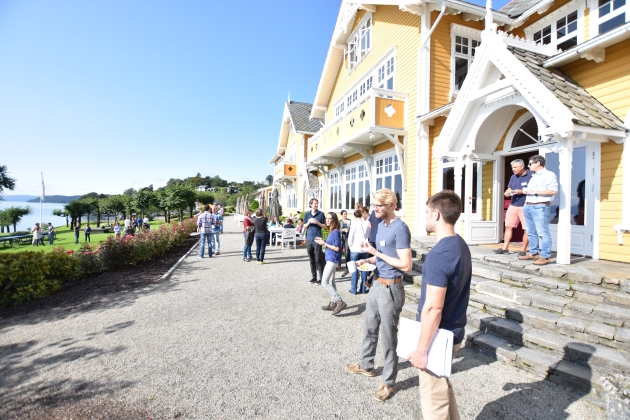
Solstrand Hotel provided a relaxed and social atmosphere for scientific discussion. (Photo: Øyvind Fiksen)

Considerable time was set aside for discussion and interaction. In these groups, a host was given a specific topic, but the participants were shifting groups every 15 minutes. In this way, multiple viewpoints and perspectives were heard. (Photo: Øyvind Fiksen)
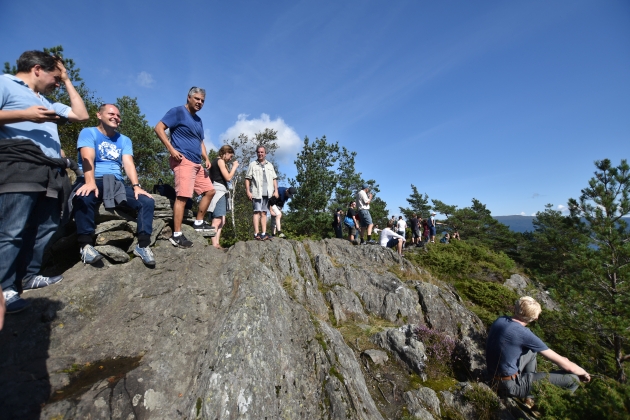
Another way participants had time to discuss was during the walk-and-talk to Borgarfjellet, in stunning weather. (Photo: Øyvind Fiksen)
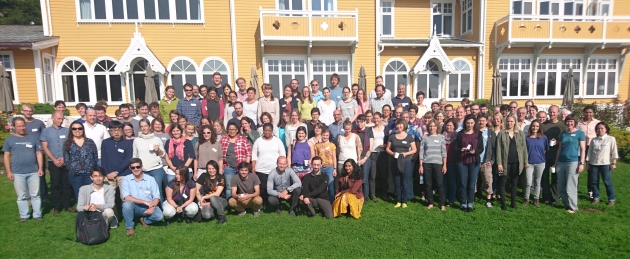
All participants (almost) of the Third Workshop on Trait-Based Approaches to Ocean Life.
The Arctic sea-ice cover is rapidly shrinking and light increasingly reaches the previously darkened waters. In a new paper in Global Change Biology, Tom J. Langbehn and co-author Øystein Varpe predict that increased visibility helps fish that hunt by sight to detect their prey.
31 July 2017
Under rising temperatures and given the more favourable feeding conditions, southerly-distributed species are likely to expand their distribution poleward. However, the foraging gains will be limited to the summer months, as the polar nigh remains dark regardless of sea-ice loss, a seasonality favouring migratory fish. Changes to the fish community will have multiple consequences for the polar marine ecosystem, particularly for the prey of fish.
The article was picked up by Frontiers in Ecology, which wrote a news story about it.
Fish farming is one of the fastest growing food production sectors in the world, but is also increasingly burdened by infections caused by bacteria, viruses, and parasites. Now, emerging research suggests that diseases of farmed fish may be evolving to become even more harmful to the animals.
20 April 2017
In a recent study published in Journal of Evolutionary Biology, Adèle Mennerat and coauthors report that salmon lice seem to have evolved higher levels of virulence (i.e. parasite-induced damage to the host) on salmon farms, as compared to lice coming from areas unaffected by farming. Another study by Sundberg et al. (Proceedings B, 2017), reports similar findings in Flavobacterium columnare, a bacterial pathogen of salmonids. This study remains correlative, and now calls for further research to decipher the causes and mechanisms of such evolution. All of this, and more, explained in The Scientist: Does farming drive fish disease?
Together with Sue Lowerre-Barbieri, Ignacio Catalán, and Ross Boucek, Anders F. Opdal and Christian Jørgensen are convening a
Theme Session on Movement Ecology at the ICES Annual Science Conference
in Florida 18-22 September 2017; Linkages between spatial ecology and sustainable fisheries.
18 February 2017
Key-note speakers for the session are are Mike Sinclair (Bedford Institute of Oceanography, Canada), Patricia Reglero (Instituto Español de Oceanografia, Mallorca, Spain) and David Secor (University of Maryland, USA).
Abstracts can be submitted at the conference website (deadline Sunday 30 April). A Themed Article Set in the ICES Journal of Marine Science is planned as follow-up from the session.
Anders F. Opdal, postdoc in the Theoretical Ecology group, contributed a chapter to the Bergen University Musem Year Book on the evolution and dynamics of the Northeast Arctic cod spawning migrations from the late 1800s to modern times.
20 December 2016
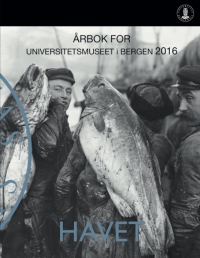
The cover photo for the 2016 Year Book of the Bergen University Museum is related to Anders Opdal's chapter.
Although the Northeast Arctic cod has its main spawning grounds around the Lofoten archipelago, a mere 700 km swim from their feeding areas in the Barents Sea, historical records show that the Northeast Arctic cod has spawned as far south as Bergen and Lindesnes (1700-1900 km). Anders asks, what could be the evolutionary drivers for such strenuous migrations, and why don't we find theses southern spawners today? The chapter is in Norwegian.
The 3rd International Workshop in Trait-based Approaches to Ocean Life will be arranged at Solstrand Hotel 20-23 August 2017, and the
Hjort Centre and the
Theoretical Ecology Group will be involved in organizing and planning the event.
22 September 2016
Anyone interested in or curious about this approach in ecology and contemporary oceanography should reserve the dates and be there! Updated information can always be found at the workshop's website: https://traitbased.b.uib.no
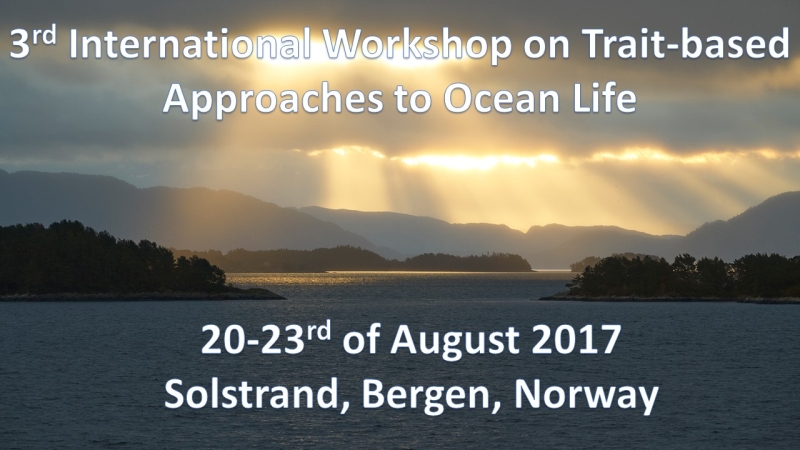
Tom Langbehn, PhD student in the Theoretical Ecology Group as part of the EU-training network MARmaED has recently been awarded two prizes for his poster on the effects of photoperiod and sea ice decline on pelagic foraging interactions.
20 September 2016
As light seasonality increases by latitude, so does its biological relevance. At high latitudes all life is adapted to the change of seasons. The general perception of the Arctic Ocean is that of an ecosystem driven by pulses of autotrophic production. However, climate-driven decline in sea ice is fundamentally bound to change the Arctic lightscape. With less sea ice, more light will reach the water. This will change both levels of primary productivity and foraging interactions of higher trophic level visual predators and their zooplankton prey. In his work, Tom demonstrates that dwindling sea ice will seasonally boost foraging of pelagic fish and that the role of light merits consideration in determining species distribution patterns and community composition beyond phytoplankton.
His poster Photoperiodic implications on visual foraging in polar marine ecosystems got awarded the student choice and special mention award at the ClimEco5 IMBER summer school and the best poster award at the YOUMARES7 conference for young marine researchers in Germany. The poster can be downloaded here.
Randi Elisabeth Åsly defended her MSc thesis Tuesday 28 June on the link between extra-pair paternity and cooperation in bird neighbourhoods.
1 July 2016

Elisabeth with her two thesis examiners: Odd Jacobsen (external, to the left) and Arill Engås (internal, right).
Extra-pair paternity is common in socially monogamous species, but explaining the adaptive benefit of this mating behaviour has proven difficult from a female point of view. In her MSc thesis, Elisabeth focused on the potential benefit of male cooperation in anti-predator behaviour, and used evolutionary modelling to explore how the number of breeding neighbours may influence cooperative benefits and mating patterns.
She found that extra-pair paternity increased male cooperative investment under most conditions, but that the best male strategy varied for different types of anti-predator behaviours. High extra-pair paternity levels were predicted to be more common in small than in large neighbourhoods, when extra-pair mating is controlled by females. This is contraty to several empirical observations, and raises interesting questions of which additional ecological factors are at play in nature, or, conversely, which factors are missing from the models.
Supervisors were Sigrunn Eliassen and Christian Jørgensen.
On Friday 17 June Thomas Njerve Olsen defended his Masters Thesis A Killing the Winner study of
visual and tactile organisms in the Black Sea.
29 June 2016

Thomas Njerve Olsen during the presentation of his thesis work.
Killing the Winner is a theoretical framework originally developed within
the field of microbial ecology to explain the coexistence of two organisms competing for a shared
resource in a homogeneous environment. The premise being that one organism is specializing in
defence and the other in growth (competition). In his thesis, Thomas has shown that the
Supervisors were Anders F. Opdal and Dag L. Aksnes.
The answer to life, the universe, and everything is not 42 - when it comes to reproduction it is another number that matters.
24 June 2016
Postdoc Adèle Mennerat and Professor Arne Skorping explain their latest finding at the Unviersity of Bergen's web pages:
uib.no: Meningen med livet er 36,8 [In Norwegian]
Does predation risk affect extra-pair mating behaviour? And is there a difference in how male and female blue tits respond to approaching predators? These are among the questions that researchers from the FRIMEDBIO project on bird mating behaviour set out to investigate this spring. The researchers were running play-back experiments and doing behavioural observations on blue tits in a population near Montpellier in southern France.
15 June 2016
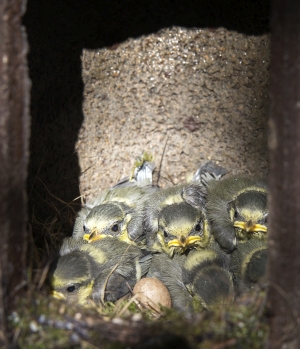
The blue tit lays clutches of 6-12 eggs, which hatch after ca. 2 weeks and the chicks fledge ca. 3 weeks later. During this period they rely on food and protection provided by both parents. (Photo: Sigrunn Eliassen)
The weasel Mustela nivalis and the common genet Genetta genetta are major brood predators in this area. When blue tit parents perceive a potential risk to their nest, they typically emit loud alarm calls and move around the trees to chase the predator away. In the experiments the researchers were interested in knowing to what extent males and females participated in the anti-predator behaviour and whether distance from the nest influenced the intensity of alarm calling.
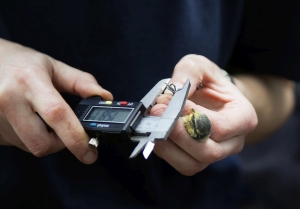
Measuring, weighing, blood sampling and ringing are part of the standard monitoring protocol for this blue tit population near Montpellier, France. (Photo: Sigrunn Eliassen)
The study site is situated in a beautiful deciduous forest and contains a network of nest-boxes that has been monitored as part of a long-term, multi-site study initiated more than 40 years ago by Jacques Blondel, and now led by Anne Charmantier at CNRS in Montpellier. From the time when nests are occupied until the chicks fledge, several hundred boxes are checked at regular intervals. Chicks are ringed and measured, and blood samples of young and adults are collected to determine parentage. Master student Marie Danielsen and postdoc Adèle Mennerat at BIO will analyse these data focusing on the link between extra-pair paternity and anti-predator behaviours.

Adèle Mennerat holding a 15-day old blue tit chick during routine measurements and ringing. (Photo: Sigrunn Eliassen)
Adèle Mennerat spends part her time at the Centre for Women's and Gender Research, and by contrasting her experiences from bird mating systems with social scientists focussing on human gender studies, a common ground is now emerging and being picked up by the national science news forskning.no.
3 June 2016
Researcher Claus Halberg at Department of Philosophy, UiB, draws perspectives from the work of Robert Trivers in the 1970s to new developments in evolutionary ecology, and finds an interesting change of focus towards understanding the female as being more active in mate choice with consequences for construction of social interactions.
You can read the whole story here [in Norwegian]:
forskning.no: Parer seg med flere hanner for å sikre ungene.
The Theoretical Ecology Group welcomes Gabriella Ljungström and Tom Langbehn, two new PhD candidates within the EU-training network MARmaED.
3 February 2016
Gabriella and Tom will model climate change effects in marine fish stocks with a focus on fish life histories. Their work is part of the EU training network MARmaED (Marine Management and Ecosystem Dynamics under Climate Change), with 8 partner institutions across Europe. The common goal is to investigate how sustainable exploitation of marine living resources and the maintenance of biodiversity can be achieved in the face of overexploitation, climate change, and other anthropogenic stressors.
Gabriella Ljungström has a broad background in science with a BSc majoring in Climate Science from Macquarie University in Sydney, Australia, and a Master of Atmospheric Science with orientation towards Environmental Sciences from the University of Gothenburg, Sweden. This broad background stems from a profound interest in how human activities lead to changes in our atmosphere and oceans, and how these changes are altering biological systems. Gabriella's PhD work within the Theoretical Ecology Group will focus on optimal harvesting under multiple human stressors by modelling how fishing and climate warming jointly determine new optima for behavioural and life history traits.
Tom J. Langbehn recently graduated from the international and interdisciplinary MSc program Marine Biology at the University of Bremen. Prior to this he took an international BSc in Environmental and Industrial Biology from the University of Applied Science Bremen, Germany. Tom is a cold water-enthusiast and therefore he choose to spend extended study and research periods abroad in Iceland, Norway, and Arctic Svalbard. Throughout his graduate and postgraduate training the focus of his work has been on (polar) marine ecology, fisheries, and fish biology, with particular emphasis on the effects that ocean climate and human activities have on the biology and adaptive strategies of fish populations. Within the Theoretical Ecology Group he will work on limits to northwards range shifts of fish stocks under climate warming.
The annual retreat for the extended Theoretical Ecology Group took place in Myrkdalen in early January. We went to a skiing resort as we often do, where some time was reserved for various skiing activities in the slopes, mountains or in the groomed tracks nearby.
15 January 2016
The group has increased in numbers recently, with the new PhD students Tom Langbehn and Gabriella Ljungström in the MARmaED project and Johanna Fall and Johanna Aarfloth from Institute of Marine Research as our associated members, and Ryan Dillon as a visiting PhD from University of Tromsø. Also, this was the first annual retreat for a number of people who arrived last year - exciting times for all of us!
At the retreat we focussed on getting to know each other, our research interests and we discussed how to structure group activities to the benefit all of us. The first day we discussed modelling and theory as a scientific method, and then we all gave short presentations on our main research agenda, and at last we developed our structure as a group. We certainly are a diverse group in terms of research themes and questions, but at the same time we share many common approaches and methods.

The Theoretical Ecology Group has grown the last year. From left to right: Sergey Buadev, Anders Opdal, Camilla H. Jensen, Christian Jørgensen, Jaqueline Weidner (partly hidden), Elisabeth Åsly, Johanna Fall, Sigrunn Eliassen, Ryan Dillon, Adèle Mennerat, Dag Aksnes, Øyvind Fiksen, Tom Langbehn, Gabriella Ljungström, Chris Lindemann, and Johanna Aarfloth.
Sigrunn Eliassen talked [in Norwegian] about female birds and sexual infidelity on the popular science radio show Ekko, aired by the NRK, Norway's national public broadcasting service.
14 January 2016
Most bird species live in socially monogamous pair relationships, but paternity tests have shown that the offpsring often belong to another father than the male who provides care at the nest. It is easy to understand why extra-pair mating is advantageous to a male, who then can sire offspring without costly and time-consuming investments in care. It is harder to explain why extra-pair mating can be advantageous to the females. Eliassen discusses how female birds can use extra-pair matings to promote cooperation between the males in the neighbourhood. The theory provides new perspective on how cooperation may arise and be maintained, and explains observed patterns of the sexual division of labour.
Norwegian text: De fleste fugler lever i sosialt monogame parforhold, men farskapstester viser at ungene ofte har en annen far enn han som bidrar med foreldreomsorgen i reiret. Fordelen med sideparinger er lett å se for hanner som slipper kostbar investering i avkom, men det er vanskeligere å forklare hvordan hunnene kan dra fordeler av dette. I følge teorier foreslått av Eliassen og Jørgensen kan hunfugler bruke sideparinger til å fremme samarbeid mellom hanner i et nabolag. Teorien gir nye perspektiver på hvordan samarbeid oppstår og forklarer mønstre i arbeidsdeling mellom kjønn.
You can listen to the podcasts here:
Short version, Saturday 9 January 2016:
https://radio.nrk.no/serie/ekko-helg/MDSP31000216/09-01-2016#t=40m41s
Longer version, Wednesday 13 January 2016:
https://radio.nrk.no/serie/ekko-hovedsending/MDSP25000816/13-01-2016#t=1h18m10s
And the theory is presented in this paper:
The first Hjort Summer school was a held at Espegrend field station in early September, with about 30 participants from all over the world and from a broad range of disciplines.
11 October 2015
The topic was Fishing and physics as drivers of marine ecosystem dynamics, with Ken Frank, Anna Gårdmark, and Hjalmar Hatun as invited teachers and lecturers. They gave an overview over current state-of-the-art in the science of how marine ecosystems are functioning, with core examples from continental shelf areas, the Baltic, and the Fareoe Islands. In addition, several of the Hjort Centre scientists contributed lectures on microbial food webs, fish-jellies, the Barents Sea, and fisheries management.
The students also presented their own research and participated actively in discussions, computer- and group exercises, and even some field work (beach seining).
As usual in Bergen, the weather was warm and sunny, and allowed for barbecue on the beach and swimming in the sea. We also made an excursion to Bergen to see the town and to do some of the touristic hikes to the surrounding mountains.
This summer school was a great success, and will be continued next year if funding is secured. Hopefully it will be a tradition, and an opportunity to bring together marine scientists in a range of disciplines to learn from the leading scientists in the field.
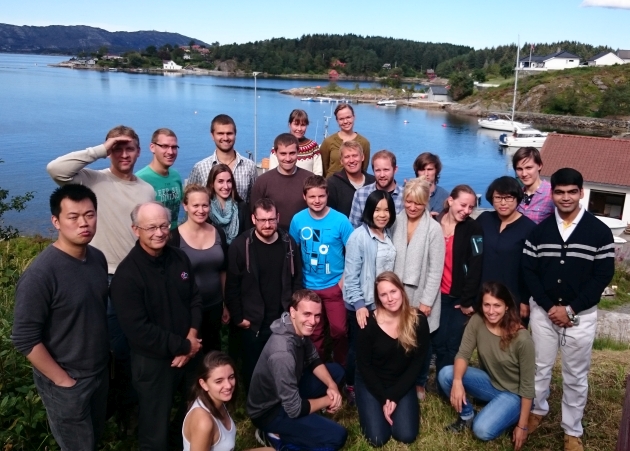
The 2015 Hjort Summer School had about 30 participants from all over the world.
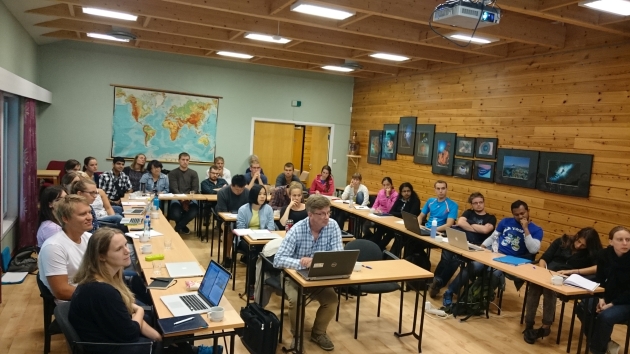
Ken Frank, Anna Gårdmark, and Hjalmar Hatun were the main teachers, and the students also presented their own research to each other.
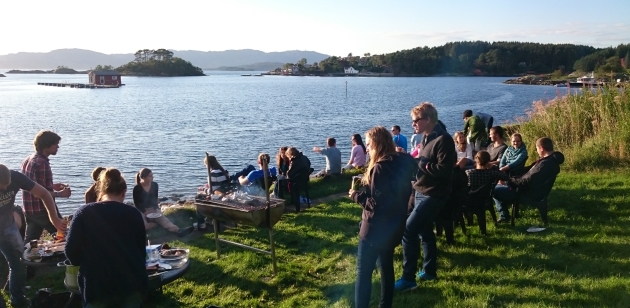
The topic was Fishing and physics as drivers of marine ecosystem dynamics and there was also time for socializing in nice weather and beautiful surroundings at Espegrend. The bravest ones even went for a (cold) swim.
We are currently seeking two PhDs (3 years each) to model effects of climate change on fish life histories. The positions are part of the EU training network MARmaED. Application deadline is 18 October 2015.
10 September 2015
PhD project A: How may climate-driven evolution of fish life histories and behaviours interact with effects of fishing?
PhD project B: With climate warming, species are expected to move northwards, but what happens when they approach high latitudes with increasing seasonality and even a long polar night?
The PhD students will be taking part in the activities of the Theoretical Ecology Group. The PhD positions will be part of the EU training network MARmaED, with 8 partner institutions across Europe. Because the positions are EU-funded, special mobility requirements apply: You cannot have been resident in Norway (the host country) for more than 12 months in total during the last 36 months (counted from starting date of the PhD position), and you are ineligible if your research experience (beyond the MSc degree) exceeds 4 years.
PhD supervisors will be Christian Jørgensen (email: christian.jorgensen@uib.no) and Øyvind Fiksen (email: oyvind.fiksen@uib.no). The workplace will be the Theoretical Ecology Group at the University of Bergen. Application deadline is 18 October 2015 and we hope the candidate can start by January 2016.
You can read the whole advertisement here:
http://www.jobbnorge.no/en/available-jobs/job/117206/two-phd-positions-in-evolutionary-marine-ecology-climate-change
On Friday 21 August Rebecca Holt defended her PhD thesis entitled Climate-induced evolution of the behaviour and life-history strategies of Atlantic cod (Gadus morhua).
31 August 2015
Opponnents were Joseph Bernardo (Texas A&M) and Tara Marshall (Univ Aberdeen).
Two of the chapters have already been published:
Rebecca E. Holt, PhD student in the Theoretical Ecology Group, recently initiated her blog at
forskning.no,
the national online science news.
8 December 2014
Public outreach is part of the PhD education at the University of Bergen, and hopefully a blog can lead to more feedback than more classical, printed outlets. Stay tuned to her blog for more...
On Thursday 30 October Daniel Sellæg defended his Masters thesis Inferring female extra-pair mating behaviour from observed patterns of extra-pair paternity with a process-based model.
7 December 2014
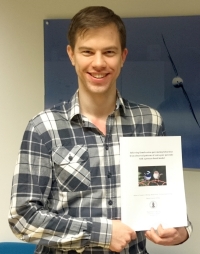
A proud Daniel with his thesis. (Photo: Bjørn Snorre Andersen.)
Using numerical models, Daniel showed that many more female birds can have extra-pair mating behaviour than end up having extra-pair young in their nest. Particularly, the difference between the female behaviour and the quantifiable output, extra-pair chicks, is large when the rate of extra-pair paternity is low or clutch size small. Supervisors were Sigrunn Eliassen and Christian Jørgensen.
Recently, Theoretical Ecology Group researchers Eliassen and Jørgensen showed in PLoSONE how female-driven extra-pair mating creates powerful incentives for male cooperation among neighbours. This week, a News & Views article in Nature by Ben Sheldon and Marc Mangel argues that the new model represents an important shift in focus for empirical studies of extra-pair mating, and that it also has broad implications for our understanding of the evolution of cooperation among unrelated individuals.
29 August 2014
Our understanding of avian mating systems was completely overturned by the invention of molecular techniques and paternity analysis, revealing that the majority of bird species, once thought to be monogamous, were instead genetically polyandrous. Since then, hundreds of studies have shown that extra-pair paternity is widespread, and sometimes as many as half of the young in a nest can be sired by a male other than the putative father. The benefits of extra-pair paternity to males are quite obvious, whereas the adaptive explanations for female-driven extra-pair mating have revolved around 'good genes' effects. Despite an extensive, and, according to Sheldon and Mangel, "rather fruitless effort," the evidence for 'good gene' benefits is weak at best.
According to the new model by Sigrunn Eliassen and Christian Jørgensen, the key evolutionary driver in the evolution of extra-pair mating lies in the distribution of a male's potential paternity across nests. When a male gains interests in several neighbouring families, this creates incentives for him to cooperate with other male neighbours and produce public goods that in turn benefit females. Sheldon and Mangel further extend this perspective, claiming that the use of adaptive dynamic modelling lays "the groundwork for investigating the broader goal of understanding the emergence of societies as complex adaptive systems."
Although data are yet not available for testing the model's predictions in ways that exclude other hypotheses, the new theory may spark a shift in empirical focus from genetic effects to the ecological costs and benefits of extra-pair mating. In conclusion, Sheldon and Mangel argue that this perspective also "has broad consequences for our understanding of the evolution of cooperation among interacting, but non-related, individuals."
I think, therefore I am, said the French philosopher Rene Descartes almost 400 years ago. Wrong, said Antonio Damasio and several others: I feel, therefore I am. While the rational mind is pretty young on this planet, feelings and their evolutionary precursors are ancient.
8 August 2014
When psychologists use the word "feeling", they mean that there is a conscious recognition of the phenomenon in the person who feels. This does not apply to emotions. The emotions are evolutionarily much older than feelings, from a time when no living being was aware its own existence.

Two emotions in a simple fish brain. (Illustration: Bjørn Snorre Andersen.)
The first study (Giske et al. 2013), which was published in The American Naturalist in December 2013, showed that "emotional" fish are more limited in their behaviour than "rational" fish, and that this restriction leads to the possible coexistence of several different "personalities" in a population. It also showed that emotions enable individuals to make good behavioural choices also in situations they have never before experienced, even if the individuals are unable to judge whether the choice was good or bad.
The second study (Giske et al. 2014), published in Proceedings of the Royal Society of London Series B, Biological Sciences in August 2014, shows that populations consisting of individuals with emotions have greater genetic variation than is necessary in relation to the environment they live in, and that this variation makes the population more adaptable to environmental changes. It therefore seems that emotions, and feelings which came much later, both led to individuals being better able to meet a wide range of challenges in a fairly good way, and to populations which are better equipped to evolve when environmental conditions so dictate.
When molecular paternity testing became available, ornithologists were shocked to reveal that birds, generally thought to be monogamous, commonly had mixed broods where some of the offspring were sired by the social male while the rest, often a substantial proportion, originated from matings with an extra-pair male. Later studies have revealed that extra-pair mating is often initiated by females, but the adaptive significance has remained elusive. In PLoS One today, Eliassen and Jørgensen argue that one of its key benefits is that it promotes neighbourhood cooperation.
2 July 2014
For males the advantages of extra-pair mating are clear: they may sire extra offspring without having to provide costly care. It is less clear why females seem to accept, or even solicit, matings outside the pair-bond. Why would a female mate with extra-pair males when it normally entails a risk that her social male will reduce on his contribution to offspring care, on which she relies?
Researchers have long looked into so-called 'good gene' effects, investigating whether extra-pair mates have better genes. One of the main predictions from the 'good genes' hypothesis is that in a brood, those offspring with an extra-pair sire should have better survival, faster growth, or otherwise higher fitness than siblings sired by the social male. Despite vast effort across several decades, few such advantages to extra-pair offspring have been found and there is emerging consensus that something else than a desire for good genes must explain the adaptive benefits to females.
In the new study, Sigrunn Eliassen and Christian Jørgensen use evolutionary models to turn the question around. A consequence of extra-pair mating is that males may have offspring in several nests. Males should therefore not aggressively monopolize a territory because that makes resources unavailable to their extra-pair offspring, by sharing they would increase their fitness. And if males face a trade-off between protecting the neighbourhood and protecting their own nest, then it may pay to cooperate over shared vigilance and defence because that safeguards all their potential offspring. Through extra-pair mating, females thus incentivize males to collectively contribute to a secure and productive neighbourhood. The advantage of extra-pair mating to females is thus a cooperative benefit produced by males.
The models further predict sex-specific division of labour, that whole nests and neighbourhoods benefit from extra-pair mating (not only the extra-pair half-siblings), and integrates with existing theory with the prediction that extra-pair mating should be more common in short-lived species.
And does it apply beyond birds? There are two key premises: paternity uncertainty, which is present also in fish, particularly those with internal fertilization, and in mammals; and paternal care interpreted in a broad sense. Within mammals, it might be rodents and primates that best fulfil the requirements.
For more details, please see the paper:
Snorre Andersen has handed in his Masters Thesis, supervised by Jarl Giske.
20 June 2014
Title: Effects of genetic complexity and time resolution in an individual-based model of mesopelagic fish with hunger and fear.
Supervisor: Jarl Giske.
Defence: Wednesday 25 June at 9:15 in K1. External examiner will be Geir Huse from IMR.
The thesis is a sensitivity analysis of the temporal resolution in a mathematical model for planktivorous mesopelagic fish. In addition, the genetic complexity of the model was increased by adding more genes, allowing more complex neuronal responses with better precision.
The increased temporal resolution of each diel cycle gave higher population egg production, the only evolutionary measure of quality in the model. Individuals changed also more frequently between the two states 'Hungry' and 'Afraid' when allowed to do so by the increased resolution. However, the overall level of fear did not stabilize or converge between simulations with higher genetic complexity, higher temporal resolution or more generations. It was found that for almost all stages of life, the increased genetic complexity was not needed and it did not yield higher population egg production. Simulation time can be shortened by a factor of 10 by reducing number of generations and diel cycles even when increasing the number of time steps in each cycle.
Scientists from the Marine Microbiology Group and the Theoretical Ecology Group at the University of Bergen recently described in PNAS how the world's most abundant organism may result from an evolutionary arms race between viruses and bacteria.
14 May 2014
The existence of the world's presumably most abundant organism was unknown to science until its appearance in DNA samples from the Sargasso Sea in 1990, which gave this organism the somewhat obscure name SAR11. This is a small bacteria whose number has been estimated to make up one quarter of all marine bacteria, implying that there are probably more than 1028 SAR11 bacteria on Earth (for comparison, the estimated number of stars in the universe is roughly 1023, i.e. there are 100 000 SAR11 bacteria for each star).
The question of what lies behind this success has fascinated microbiologists, not the least because SAR11 is a simple organism with a small genome and hence few genes. Why is such a minimalistic strategy apparently key to success? The debate has first and foremost been guided by the ideas that SAR11 either is so successful due to its ability to defend itself against viruses and predators, or due to its ability to compete with other bacteria for limiting resources. In the last issue of the prestigious American science journal PNAS (Proceedings of the National Academy of Sciences), scientists from the Department of Biology at the University of Bergen have analysed the following trade-off: If the cost of viral defence is high in terms of reduced growth and reproductive ability (and vice versa), then those individuals investing too much into competition will be eaten or get infected, and those who invest too much into defence will starve. A logical consequence is that the key to success appears not to lay in either of the two extremes, but rather in using a level of defence where the price in terms of reduced competitive ability is minimal. Instead of considering SAR11 as a species composed of similar individuals, the scientists show how an evolutionary arms-race between SAR11 bacteria and their viruses leads to a number of different clones within the SAR11 bacteria, where some clones are strong competitors for limiting resources and others have strong defence against viruses, while most of the clones lie between these two extremes.
The work is part of the recently completed PhD thesis by Selina Våge and was conducted as part of the ERC Advanced Grant project MINOS to professor Frede Thingstad. The work gives a theoretical framework that can link genetic information from molecular analyses to marine ecosystem properties.
Read more in the original article, which was published in PNAS online on 13 May 2014:
Friday 4 April at 10:15 Selina Våge is defending her thesis entitled Pelagic microbial food web organization: Extending the theory for structure and diversity generating mechanisms based on life strategy trade-offs .
29 March 2014
Opponents are Mick Follows (Massachusetts Institute of Technology, USA) and Andy Visser (Technical University of Denmark), and the defence will take place in Stort auditorium, Høyteknologisenteret, Thormøhlensgate 55.
For more info see the UiB press release (in Norwegian).
We had a wonderful day with seminars and discussions as
the Theoretical Population Ecology and Evolution Group from
Lund University, Sweden, visited us in Bergen.
21 March 2014
They were on a week-long Nordic road-trip, and arrived from the University of Oslo by train and, despite the stormy weather, continued to NTNU in Trondheim with the coastal ferry Hurtigruten.
Per Lundberg led the group to the Department of Biology with astonishing temporal and spatial precision. He talked about the utility, or lack thereof, associated with theoretical modelling. Jacob Johansson presented a model for phenology in migrating birds, with a follow-up talk by Nadiah Kristensen. Mikael Pontarp and Jörgen Ripa were also visiting. After lunch it was time for seminars given by Bergen researchers.
Norway's Prime Minister Erna Solberg officially opened the Hjort Centre for Marine Ecosystem Dynamics on 18 February, Hjort's 145th birthday.
20 February 2014
Present were also the Fisheries Minister Elisabeth Aspaker and the City Mayor of Bergen Trude Drevland. The Hjort Centre is a collaboration between University of Bergen, Uni Research, Institute of Marine Research, and Nansen Environmental and Remote Sensing Center, and several researchers from the Theoretical Ecology group have been central in developing the concept and drafting the Science Plan.
You can read more about the Hjort Centre opening (in Norwegian) at:
Here are some further background news stories:
The Norwegian Public Broadcaster NRK has picked up the article by Dag L. Aksnes and colleagues in Nature Communications, which claims that about ten billion tonnes of mesopelagic fish remain unexploited in the deep oceans.
13 February 2014
- We might need to start fishing further down in the food chain to provide the world's growing population with enough nutrients. The vast abundance of mesopelagic fish represents an obvious opportunity, Dag says.
Read the full story at the NRK webpages.
The article itself can be found here:
Selina will give her trial lecture Friday 14 February 12:15.
10 February 2014
Title: Mechanisms for and population diversity consequences of parasite defense throughout the tree of life.
Evaluation Committee: Professor Arne Skorping, Researcher Sigrunn Eliassen, Professor Ruth-Anne Sandaa.
Time and place: Friday 14 February 12:15, Seminar room K3, Biologen (Thormøhlensgate 53B).
Everyone is welcome.
Selina will defend her thesis Friday 4 April.
Opponents: Mick Follows (MIT), Andy Visser (DTU), and Lise Øvreås (UiB).
Thesis title: Pelagic microbial food web organization. Extending the theory for structure and diversity generating mechanisms based on life strategy trade-offs.
Mesopelagic fishes dominate the global fish biomass, yet there exist major uncertainties regarding their real abundance. In Nature Communications today, Dag L. Aksnes is co-author on a paper arguing that the commonly accepted biomass estimate of mesopelagic fishes of one billion tonnes should be raised by an order of magnitude.
7 February 2014
The new estimate is based on analysis of nine months of acoustic data collected during a circum-global scientific cruise.
This finding is consistent with a recent paper (Kaartvedt et al. 2012, see link below) which suggested that mesopelagic fish have been drastically underestimated because of their efficient avoidance of traditional sampling gear. The contribution of the mesopelagic fishes to e.g. ocean biogeochemical cycling was deemed insignificant based on previous estimates of their biomass, but this thinking may have to be revised. Furthermore, it appears that the trophic efficiency in the open ocean is much higher than previously assumed.
Why do females engage in extra-pair copulation (mating with other males than their own partner) - and what are the resulting selective pressures on male behaviour (how should males respond to this)? The (scientific) temptation was too big: Adèle Mennerat has joined TEG for four years to work with Sigrunn Eliassen and Christian Jørgensen on an ongoing project studying promiscuity and the evolution of cooperative neighbourhoods, and funded by the Research Council of Norway. She is also holding an Associate Professorship at the University of Amiens (France), from which she could take a temporary leave for the duration of the project.
22 January 2014

Adèle with two blue tits.
Her research interests lie at the interface of evolution, ecology, and behaviour. She has background in both Molecular Biology (ENS Lyon, France) and Evolution & Ecology (University of Montpellier, France) and a PhD in Population Biology and Ecology (CEFE / University of Montpellier, France). Her PhD thesis focused on the adaptive value of animal self-medication behaviours. She has previously worked at UiB as a researcher (2008-2010) in the Evolutionary Ecology Group, working on life history and virulence evolution of parasites with Arne Skorping. She then spent two years as a Marie Curie fellow at the Edward Grey Institute at the Department of Zoology of Oxford University, studying the links between disease transmission and social behaviour. In Amiens she is exploring life history evolution and terminal investment, invasion ecology, and epidemiological consequences of climate variability. She has addressed those questions using various model species from bacteria to fish although birds remain her favourite group.
In Bergen she will use empirical data from the "real world" to test assumptions and predictions from models developed by Sigrunn & Christian, starting with birds and later on expanding the scope to other groups (including primates).
Kristina Kvile is a visiting PhD student through the
Nordic Centre of Excellence network NorMER.
20 January 2014
She will stay in Bergen for almost two months, and the focus of the stay is
to investigate zooplankton survey data from the Barents Sea in the light
of a hydrodynamic model of the area and an individual based model of
Calanus finmarchicus. With this, she hopes to shed light on the spatial
dynamics of C. finmarchicus in the Barents Sea.
Kristina is normally based at the Centre for Ecological and Evolutionary
Synthesis (CEES) at the University of Oslo.
You can read more about her project here:
http://www.mn.uio.no/cees/english/people/phd/kristokv/
The small city of Bergen already produces so many peer-reviewed publications
within marine science that it is on the top 10 list worldwide, but a challenge
has been to convert mass into momentum. In an attempt to raise ambitions and put
the big questions on the agenda, four institutions in Bergen have now agreed to
collaborate in a Hjort Centre for Marine Ecosystem Dynamics.
19 January 2014
The partners are:
The centre's ambition is to become an international point of gravity in marine ecosystem research worldwide.
The Centre is named after Johan Hjort, often referred to as the founder of modern fisheries science due to his contributions and particularly the book Fluctuations in the great fisheries of Northern Europe (1914). Most of his groundbreaking research was done in Bergen, where Hjort became Norwegian Fisheries Director and simultaneously the first director of the Institute of Marine Research.
The Hjort Centre will have its official opening on Tuesday 18 February 2014, and there is currently hectic activity on developing the Science Plan with heavy involvement from the Theoretical Ecology Group.
By the end of August all members of the Theoretical Ecology Group will have moved to their new offices within the main building of the Department of Biology.
18 August 2013
Since the Department of Biology became co-located in its new buildings roughly three years ago, the Theoretical Ecology Group has been living a life in isolation in the building next door. Although the distance has not been more than a few meters, we have missed the daily joy of bumping into colleagues in the corridors. Not so any more. By the end of August all members of the Theoretical Ecology Group will have moved to their new offices within the main building of the Department of Biology. From then on you find us in Thormøhlensgate 53B, floor 3, with postdocs on floor 2. Further good news is that we now will share corridor with Evofish and the Evolutionary Ecology Research Group. We are looking forward to new interactions!
PhD student Selina Våge, together with PhD student Julia E. Storesund and professor Frede Thingstad, extend the ongoing discussion of why SAR11, an abundant bacterial group in the pelagic ocean, is so successful.
6 August 2013
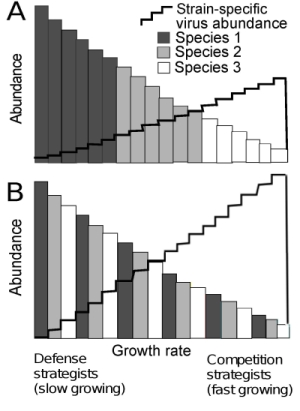
A figure from the article, illustrating two possible scenarios (clustered (A) and interspersed (B)) of how strains of bacterial species may be distributed along the growth rate axis. The interspersed scenario (B) supports the highest total virus abundance according to our model, and allows for a dominance of defensive SAR11 strains despite a high SAR11 virus abundance.
Our paper on fishing-induced evolution of growth was listed first among the most accessed papers in Marine Ecology in 2012.
11 July 2013
The journal's list is here:
http://onlinelibrary.wiley.com/journal/10.1111/(ISSN)1439-0485/homepage/MostAccessed.html
We have a new PhD student in the group - Nadia Fouzai started late last year and is already developing her first paper on how temperature operates to influence physiology, behaviour and eventually growth and survival in larval cod.
11 February 2013
Nadia's PhD project is connected to the Nordic Centre of Excellence NorMER (The Nordic Centre for Research on Marine Ecosystems and Resources under Climate Change). Her thesis will be on how temperature and other climate-related environmental factors can affect the survival of larval cod. Supervisors will be Øyvind Fiksen, Anders F. Opdal, and Christian Jørgensen.
Nadia did her undergraduate at National Institute of Agronomy of Tunisia (INAT), then she went to Spain to take a Masters of Science degree within the field of Fisheries economics and management, at University of Barcelona. Her Masters thesis was entitled Management of the Adriatic Sea Exploited Marine Ecosystem by means of the Application of Ecopath Modelling and the Simulation Tool Ecospace, taken at Institute of Marine Science (ICM-CSIC), Barcelona, Spain. Her thesis was later published in Journal of Marine Systems, see below. She speaks Arabic, French, Spanish and English - and has just started on a Norwegian course.
According to her own words she is not deterred by the climate in Bergen. We hope she will adapt to the local climate, just as her cod larvae!
In a feature article in the Norwegian national newspaper VG, researcher Anders F. Opdal commented on the ongoing research in the Theoretical Ecology Group on how a modern trawl fishery has altered both demography and spawning distribution of the Northeast Arctic cod stock.
10 February 2013
The Norwegian national newspaper VG recently published an article focusing on the negative effects of trawling, directed towards the ongoing debate concerning future oil production in Lofoten, an important spawning area for the Northeast Arctic cod. Journalist Inga R. Holst argued that not only the oil industry, but also the fishing industry faces serious environmental challenges. Researcher Anders F. Opdal commented on the ongoing research in the Theoretical Ecology Group regarding the negative consequences trawling, and how a modern trawl fishery has altered the both demography and spawning distribution of the Northeast Arctic cod stock. You can read the whole story here.
The program for the annual Darwin Day, on Tuesday 12 February, is now out. Professor Andrew Read from Pennsylvania State University will talk about drug resistance, evolving pathogens, and evolutionary medicine.
9 January 2013
At 12:00 he will give a talk at Haukeland University Hospital, and at 18:00 a lecture at the Student Centre. The evening lecture is arranged in collaboration with the Horizons seminar series by the Faculty of Mathematics and Natural Sciences at UiB, and the lunch lecture in collaboration with Centre for International Health and Haukeland University Hospital.
The web pages of the Darwin Day in Bergen.
The web pages of Andrew Read's research group.
The funding of our new project on the evolution of mating systems was highlighted by the Norwegian national newspaper Aftenposten as the type of innovative science the Research Council of Norway would like to support more strongly in the coming years.
3 January 2013
Project leader Sigrunn Eliassen and researcher Christian Jørgensen recently received news that a new four-year project on the evolution of mating systems received funding by the Research Council of Norway. The Norwegian national newspaper Aftenposten highlighted this as the type of innovative science that the national funding body would like to support more strongly in the coming years. A post-doc will be recruited to the project, and work in collaboration with the University of Bergen's Center for Women's and Gender Research.
Read the article in Aftenposten here [In Norwegian].
Read story at The Research Council of Norway webpages here [In Norwegian].
Øyvind Fiksen has been on a one-year sabbatical at Massachusetts Institute of Technology (MIT) in Boston, USA, working with Mick Follows and his group The Darwin Project.
6 September 2012
Trait-based ecosystem models are becoming more popular and taken into use in a wide range of applications and questions in oceanography. Read more about what they think about the future for Trait-based ecosystem models here:
Dag L. Aksnes is coauthor of the Featured Article in the current issue of Marine Ecology Progress Series. The paper shows how internal waves vary the thickness of a turbid surface layer, causes a fluctuation in light intensity of 3 to 4 orders of magnitude, leading fish to migrate vertically, but now with a period of 30 min instead of 1 day.
26 April 2012
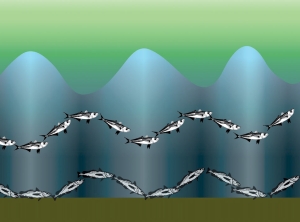
A figure from the article, illustrating the effect of the internal wave on fish distributions. Each wace cycle is about 30 minutes. (Illustration by Hege Vestheim.)
The major upwelling systems of the oceans sustain a large part of the world fisheries. The high productivity of these systems has been attributed to high primary production, short food chains, and high trophic transfer efficiency. The study Internal wave-mediated shading causes frequent vertical migrations in fishes suggests that frequent vertical migration (FVM) in fish might contribute to increased prey encounters and the time available for safe visual foraging, thus improving fish growth and survival and trophic transfer efficiency in the Benguela upwelling system. The observed FVM appears to be facilitated by the periodic shading of downwelling irradiance due to the action of internal waves. The thickness of a turbid surface layer varies with the wave and causes a fluctuation in light intensity of 3 to 4 orders of magnitude. Like diel vertical migration, the fish respond by vertical migration, but now with a period of 30 min instead of 1 day. Thus it is hypothesized that fish feeding is enhanced due to an increase in the daily number of antipredation windows for feeding in the water column.
Effects of interactions between fish populations on ecosystem dynamics in the Norwegian Sea - results of the INFERNO project is the title of a special issue of Marine Biology Research published today.
25 April 2012
Geir Huse, Jens Christian Holst, Kjell Rong Utne, Leif Nøttestad, Webjørn Melle, Aril Slotte, and Geir Ottersen are guest editors. The volume includes several articles using the Norwecom end-to-end model, with contributions from Geir Huse, Solfrid Hjøllo, Morten Skogen, and Kjell Rong Utne, among others. The Special Issue is found online at http://www.tandfonline.com/toc/smar20/8/5-6.
Starting April 2012, the Theoretical Ecology Group arranges a weekly seminar series on marine ecological modelling, with a special focus on issues of relevance for development of the NORWECOM end-to-end ecosystem model.
21 April 2012
Starting April 2012, the Theoretical Ecology Group arranges a weekly seminar series on marine ecological modelling, with a special focus on issues of relevance for development of the NORWECOM end-to-end ecosystem model. Talks may include a wide variety of topics in quantitative ecology. The seminar series is a meeting point for ecologists, geophysicists, mathematicians, and computer scientists from UiB (Dept. of Biology, Geophysical Institute, Dept. of Mathematics), Uni Research, Institute of Marine Research, and other research institutes, and is open to all interested.
We received a total of 45 applications for the 3-year PhD position connected to the Nordic Centre of Excellence NorMER.
11 April 2012
A total of 45 applications was received for the 3-year PhD position connected to the Nordic Centre of Excellence NorMER. The successful candidate will model responses in cod larvae to climate change, and work with Øyvind Fiksen, Christian Jørgensen, and Anders F. Opdal.
A 3-year PhD position connected to the Nordic Centre of Excellence NorMER is now announced.
23 February 2012
The successful applicant will perform theoretical modelling studies on larval cod growth and survival in scenarios of future oceanographic conditions. The research question is how recruitment success of larval cod will depend on changes in environmental and ecological conditions such as ocean temperature, acidity, primary production, optics and prey availability. The candidate will apply optimality modelling and individual-based models to integrate from physiological processes to ecological and evolutionary mechanisms involved in long-term changes of the environment.
We are seeking a highly motivated candidate with background in one or more of the following disciplines: biological oceanography, ecology, evolution, behavioural ecology, larval fish biology, life history theory, physiology and theoretical biology. Candidates with backgrounds from related disciplines will also be considered. Good communication and writing skills in English and a desire to engage in collaborative research are essential.
For further information and to apply, please visit
http://www.jobbnorge.no/job.aspx?jobid=81311
(you may need to click 'English' in the top menu to change language). The application deadline is 30 March 2012.
Perdana Karim Prihartato is an Indonesian PhD student of professor Stein Kaartvedt at the Red Sea Research Center at KAUST in Saudi Arabia.
4 October 2011
He visits TEG in October 2011 to learn Dynamic Programming and to start modeling the life history and behavior of Red Sea mesopelagic fish by this method. He is cooperating here with Rune Rosland (who studied Norwegian mesopelagic fish by the same modeling tools in his PhD) and Jarl Giske, who is also his co-supervisor at KAUST.
The Theoretical Ecology Group met for two days at Herdlevågen Gjestehus. The hotel used to be the marine biological
station of Bergen, but was abandoned to avoid noise and pollution as the city's airport was planned at Herdla. As
the institute moved to Espegrend, so did the airport plans, and Espegrend is ironically now the closest neighbour to Flesland.
14 June 2011

Jarl blended in perfectly as he gave a talk on modelling proximate mechanisms for decision-making in fish.
In addition to members from the Department of Biology, researchers from Institute of Marine Research (IMR) and Uni Research (Uni) were also present. Part of the discussions revolved around plans for how to establish a research centre with all three research institutions involved.
Two new faces also joined the meeting and presented their science. Rebecca Holt is beginnig a PhD on cod and climate change in September. Leo Zijerveld is a long-term visitor from the Sottish Agricultural College in Edinburgh, and is completing a PhD on the dynamics of disease outbreaks.
Since Øyvind Fiksen will be on sabbatical at the Massachusetts Institute of Technology the upcoming academic year, Dag L. Aksnes was elected new group leader from 1 August 2011.
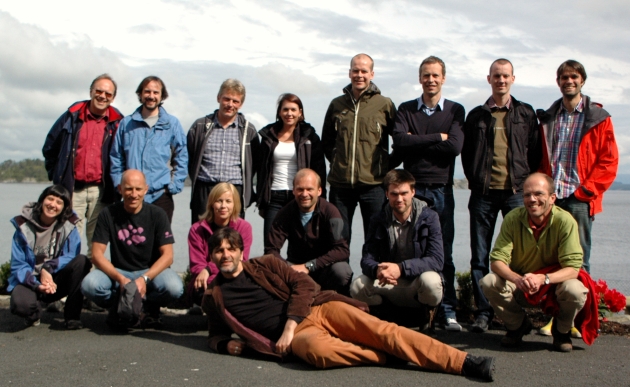
The extended Theoretical Ecology Group at Herdla. Back row (from left): Jarl Giske, Nicolas Dupont, Rune Rosland, Rebecca Holt, Frode Vikebø (IMR), Geir Huse (IMR), Kjell Utne (IMR), Christian Jørgensen (Uni). Front row: Agurtzane Urtizberea, Dag Aksnes, Sigrunn Eliassen, Øyvind Fiksen, Anders Frugård Opdal (Uni), Leo Zijerveld (visitor). In front: Marco Castellani.
Rebecca Holt from Plymouth, United Kingdom, has been offered the position as PhD Student in connection
with the Nordic Centre of Excellence NorMER (The
Nordic Centre for Research on Marine Ecosystems and Resources under Climate Change).
13 June 2011
Rebecca plans to begin in September, and her thesis will study temperature adaptations in cod. Supervisors will be Christian Jørgensen and Øyvind Fiksen.
There were a total of 52 applicants, ten were interviewed, and Rebecca was ranked first by the committee.
Leo Zijerveld is a visiting PhD Student from Biomathematics & Statistics Scotland, Sottish
Agricultural College.
12 June 2011
His interests are stochastic models for the spread of disease in heterogeneous wildlife populations. To derive parameter estimates for such models, he uses time series data and Markov Chain Monte Carlo inference techniques.
A stunning fifty-two applications were received for the recently announced PhD position as part of the Nordic
Centre of Excellence NorMER (The Nordic Centre for Research on Marine Ecosystems and
Resources under Climate Change).
27 April 2011
Several of the candidates are excellent, and interviewing will begin soon. But first one has to get throughly through the nearly 2000 pages of letters and documentation to make sure everyone has been evaluated fairly.
We currently have a four-year PhD scholarship open. The position is part of
The Nordic Centre for Research on Marine Ecosystems and
Resources under Climate Change, and will involve evolutionary modelling of adaptations to
climate change in the Atlantic cod.
17 February 2011
The application deadline is 30 March 2011. Follow this link to find out more.
Anders F. Opdal defended his PhD thesis in November 2010 and has now been hired as researcher
in Uni Computing.
10 February 2011
His focus will be to combine models of fish larval survival and drift from oceanography models, with life history models for the adult phase in a fish's life. The aim is to close the life cycle in a broad perspective by coupling these modelling tools. The research is funded by the Research Council of Norway through the Havet and Kysten thematic programme.
Professor Marc Mangel at
University of California Santa Cruz
joined TEC in November 2010 as Adjunct Professor at Department of Biology.
1 February 2011
His relationships with TEC date back to the early 1990s. He has been guest lecturer on several UiB PhD courses, co-supervisor for UiB PhD students, host for TEC researchers at sabbaticals, and co-authors in several of our journal articles. In his adjunct professorship he will participate in three TEC core activities, namely Evolution of mating systems, Evolution in Fisheries Science, and Animal Decision Making.
More information about Marc can be found at his web page: http://users.soe.ucsc.edu/~msmangel/.
The Nordic Center of Excellence NorMER (The Nordic Centre for Research
on Marine Ecosystems and Resources under Climate Change) was granted funding November 2010
and is now launching its activities.
21 January 2011

Visit www.nordforsk.org.
The center is led from the Univesity of Oslo (chaired by Professor Nils Christian Stenseth) in conjunction with the Stockholm Resilience Center (Professor Carl Folke is co-chair). Department of Biology, University of Bergen, is one of nine nodes across the Nordic countries.
Øyvind Fiksen leads the UiB involvement. You can read more about the network and its organisation at http://www.normer.org
The network will research climate change effects on Atlantic cod, a species with a wide distribution in Nordic waters and of great regional economic importance. The main activity of the centre will be to fund 16 PhD students and 4 postdocs that will visit several of the nodes. The first positions will be announced 18 February 2011 with application deadline 30 March 2011.